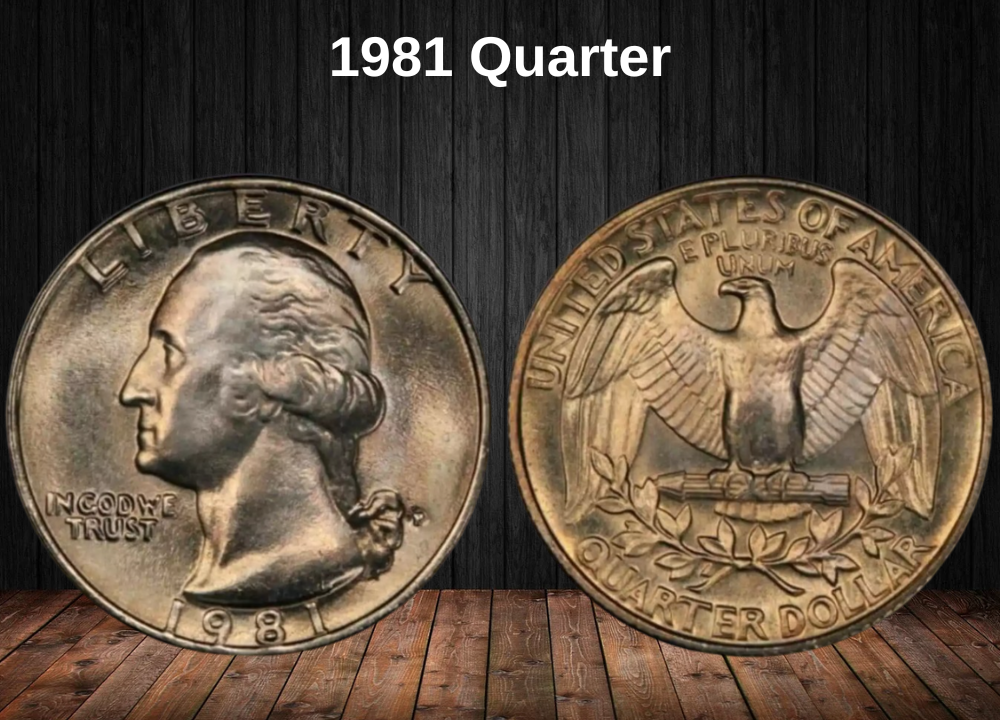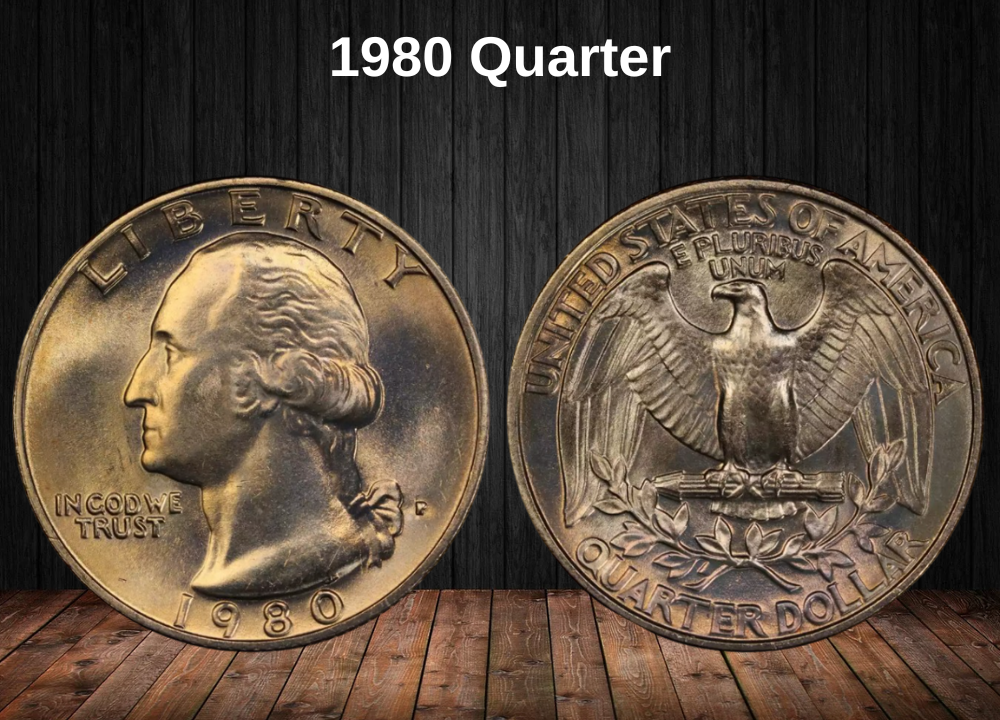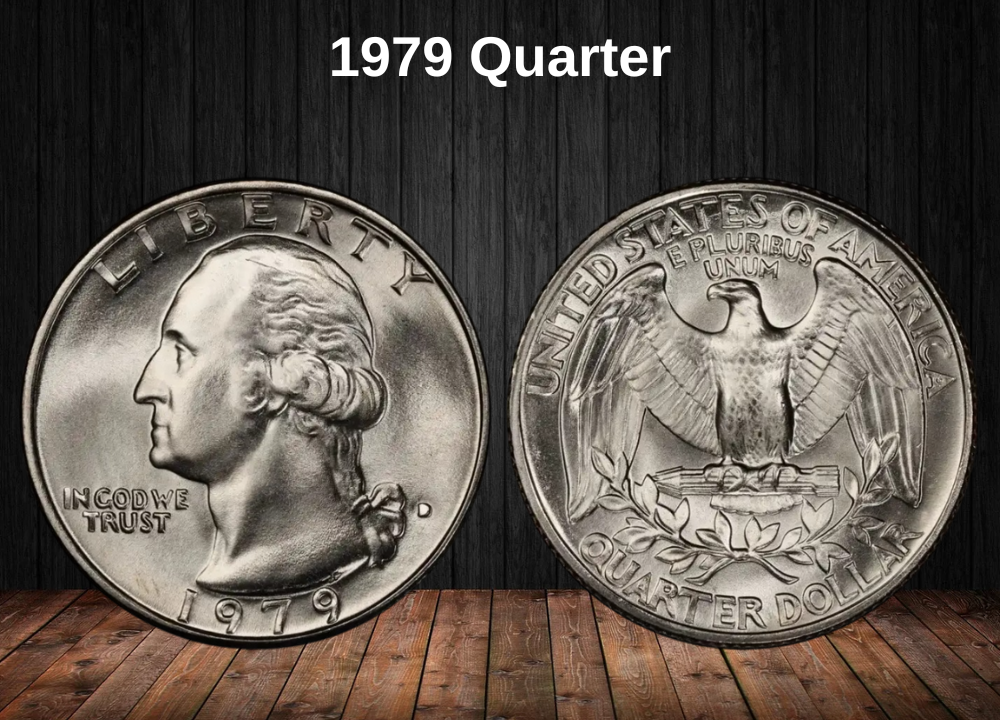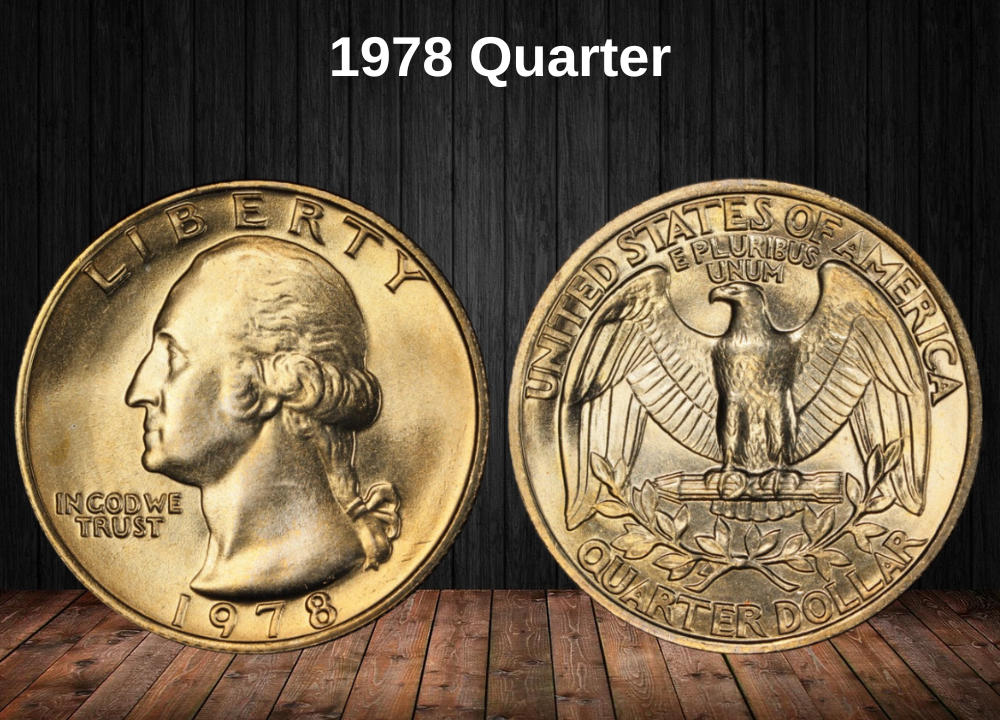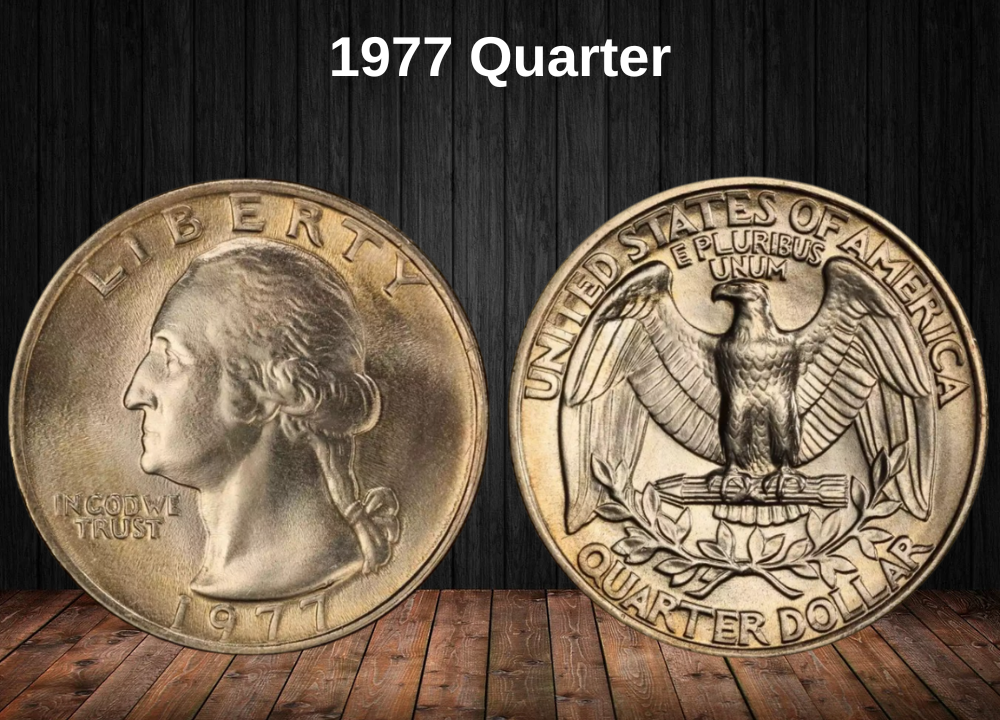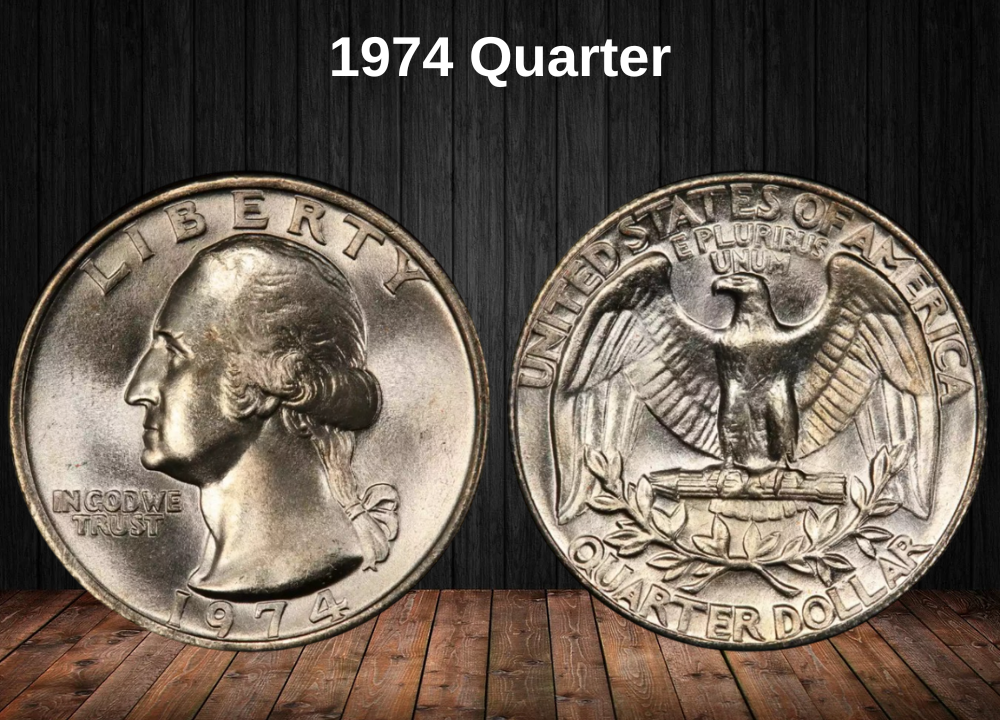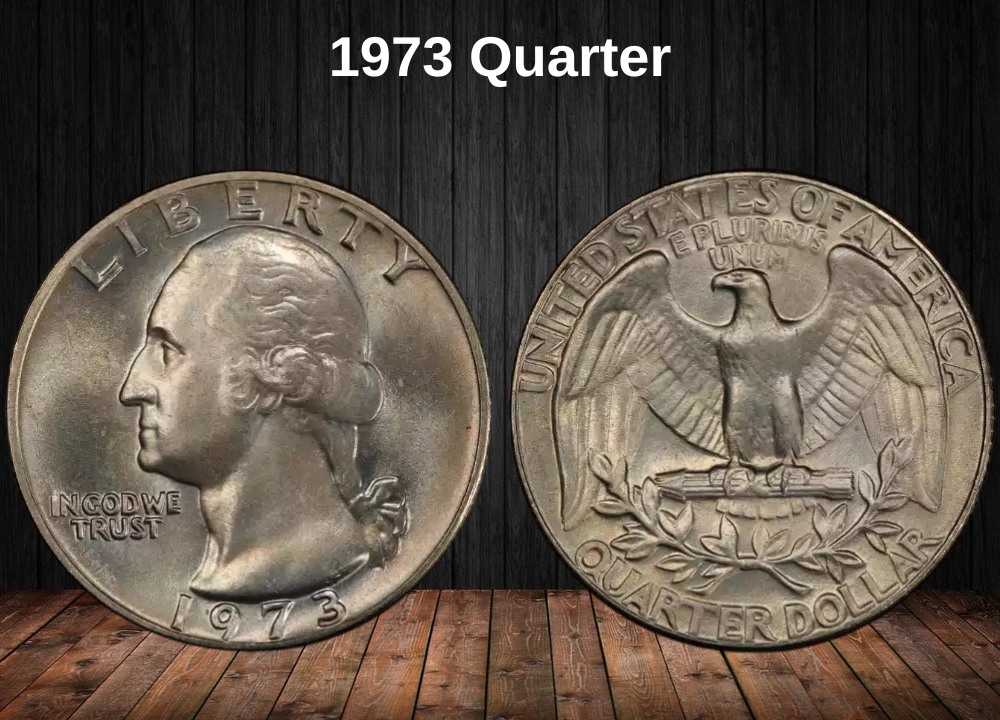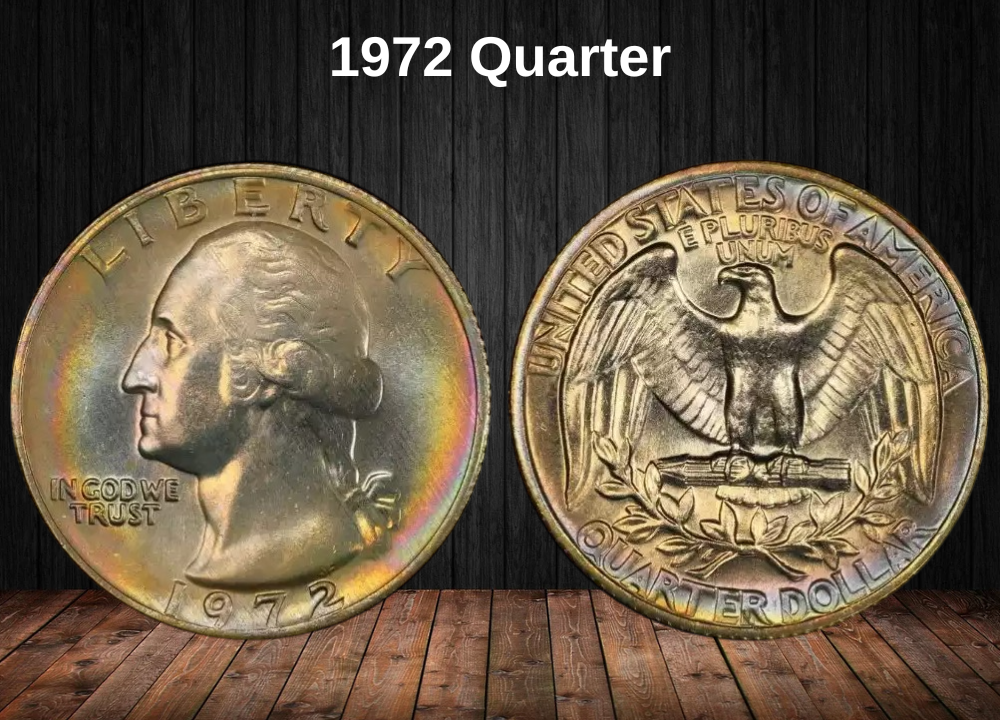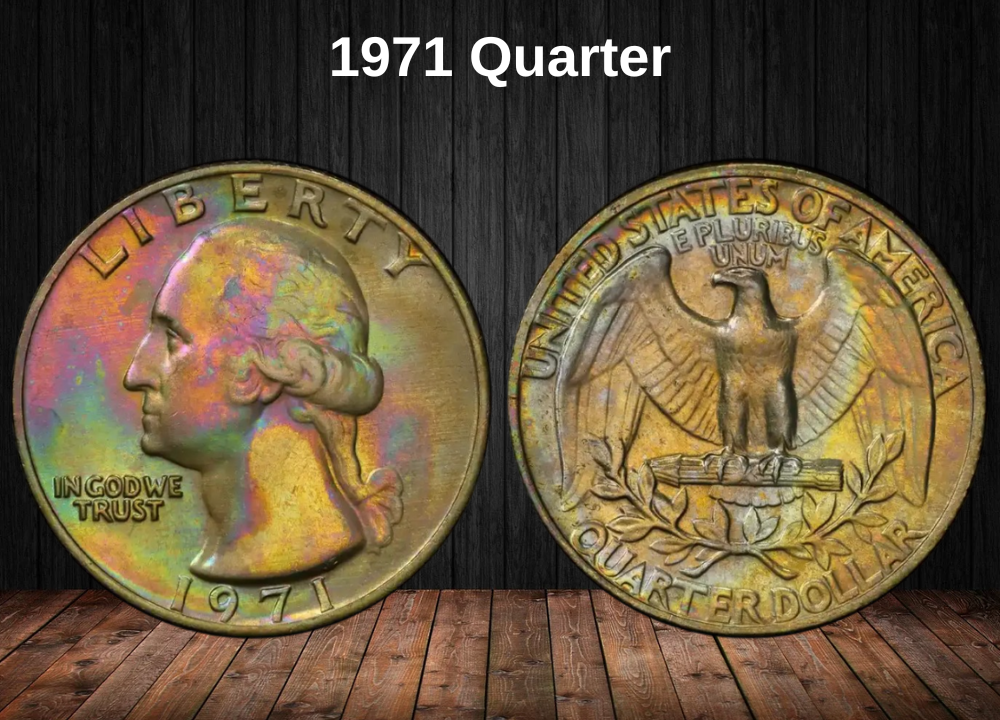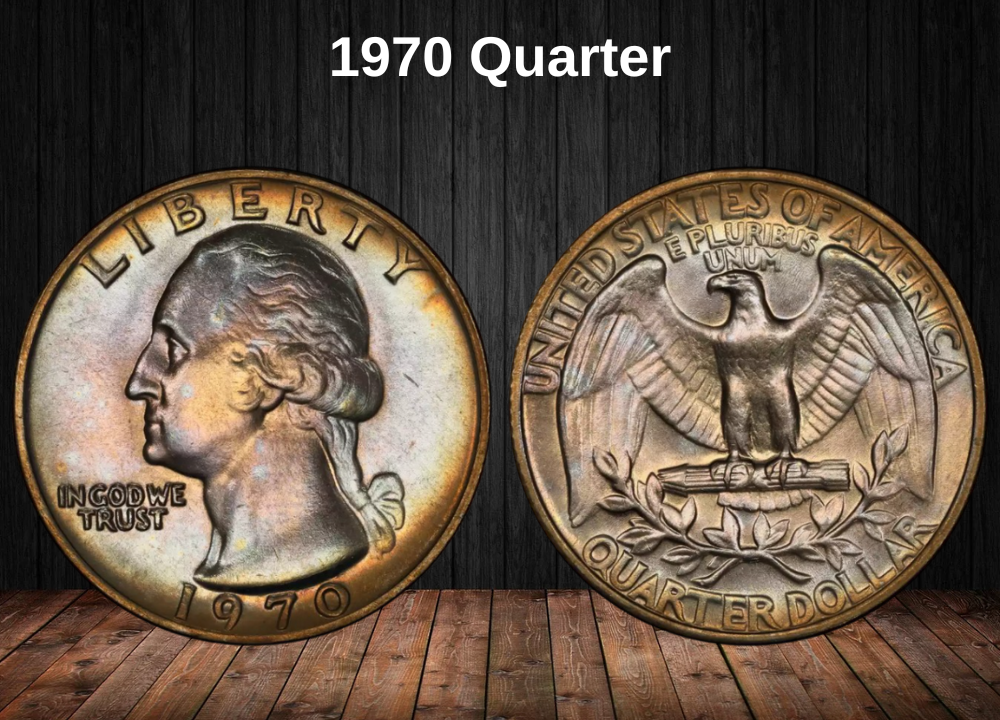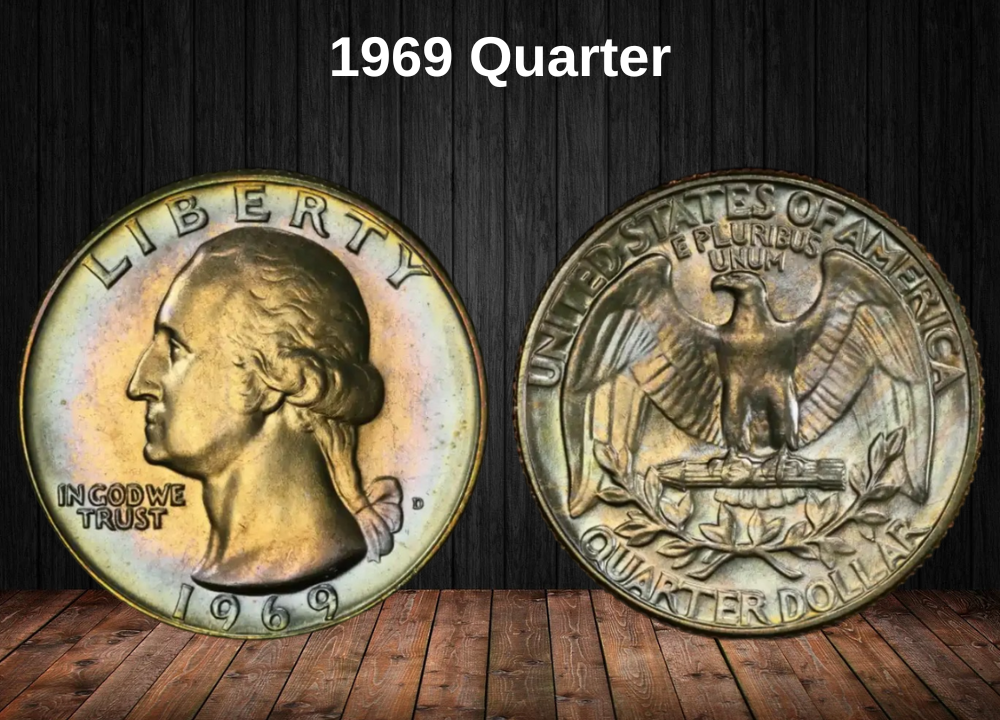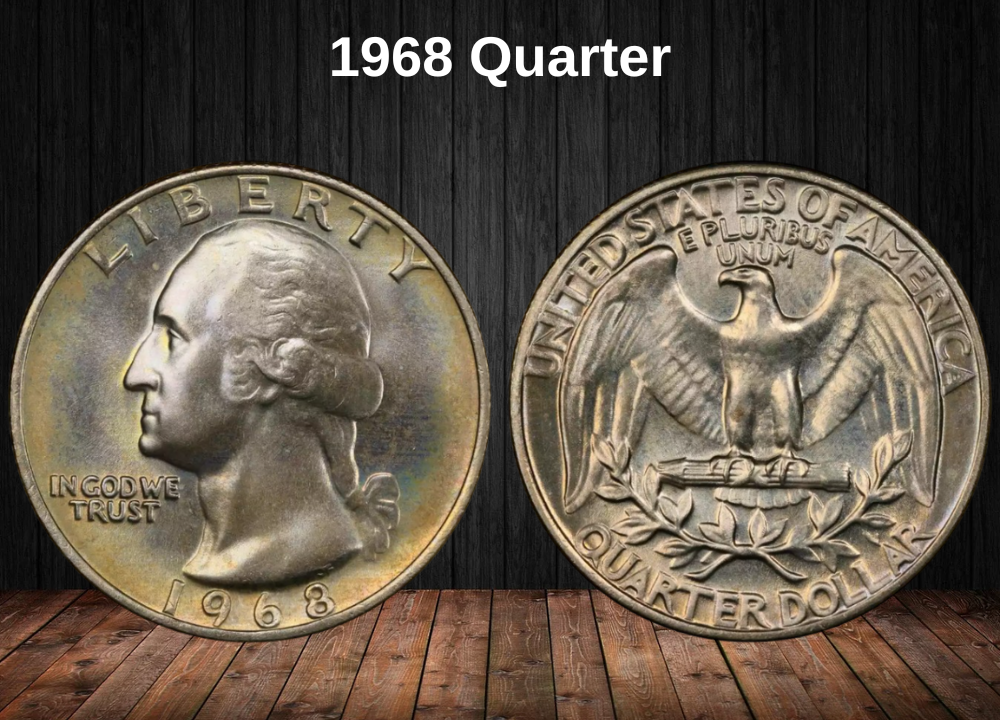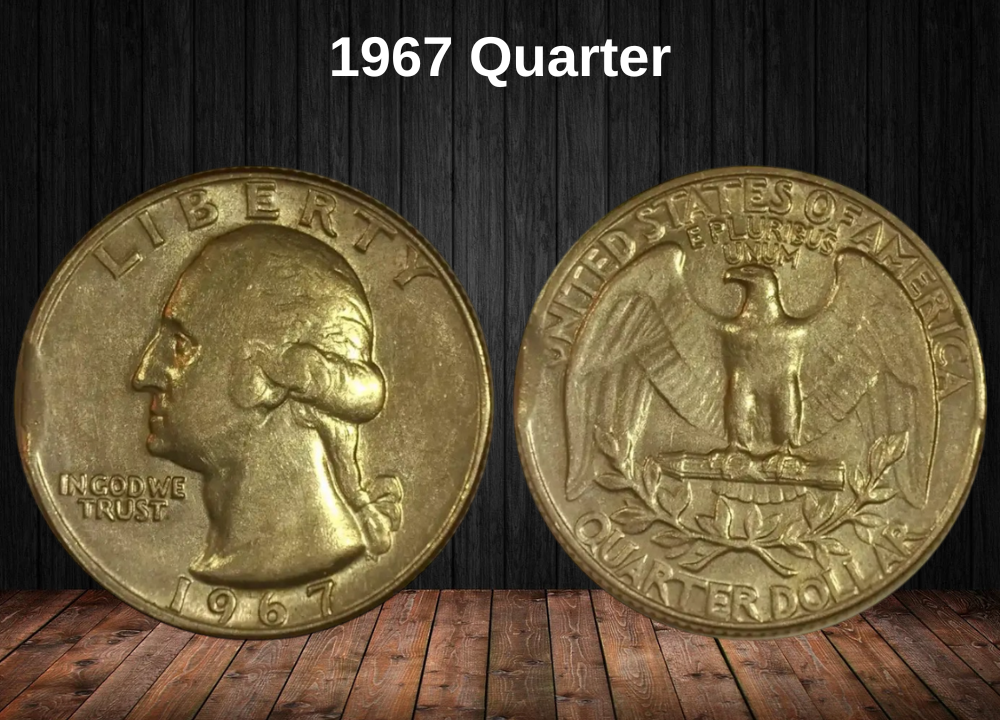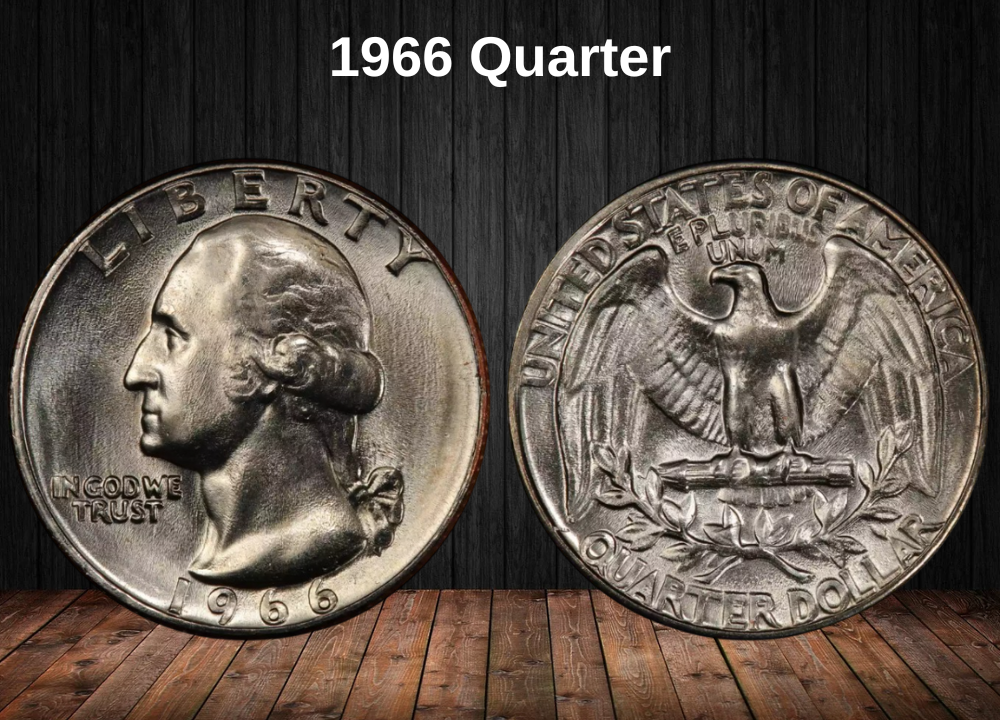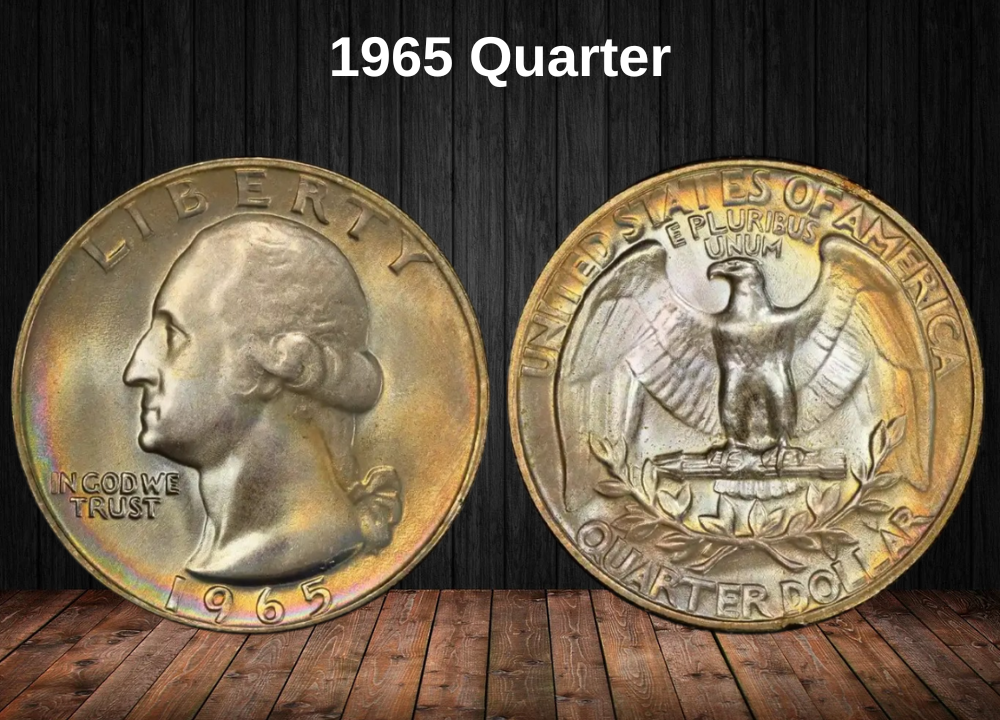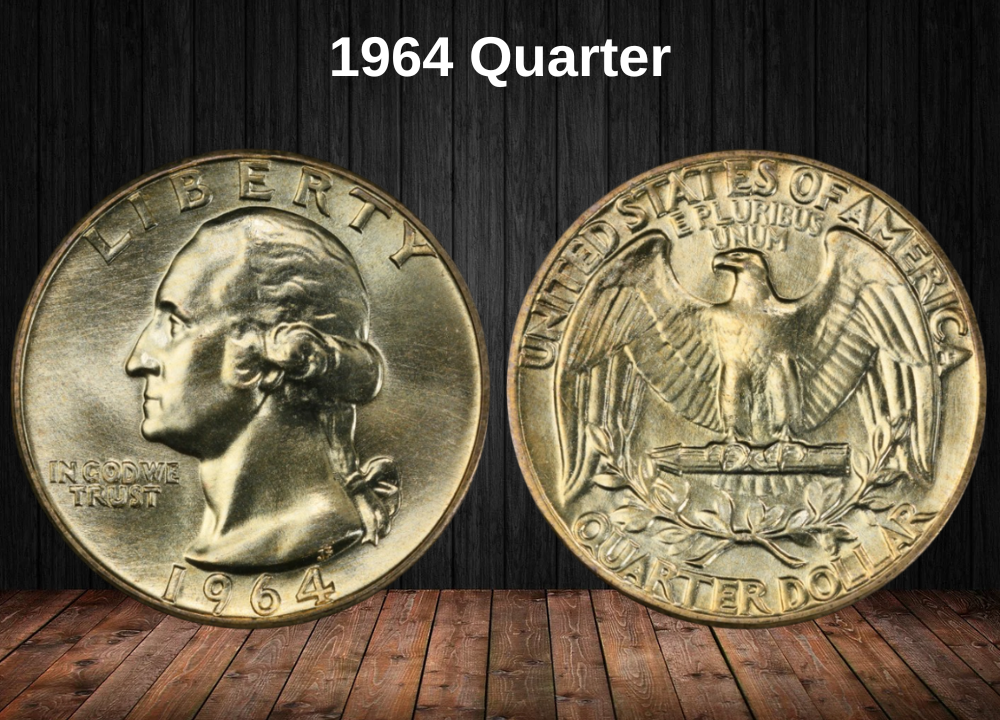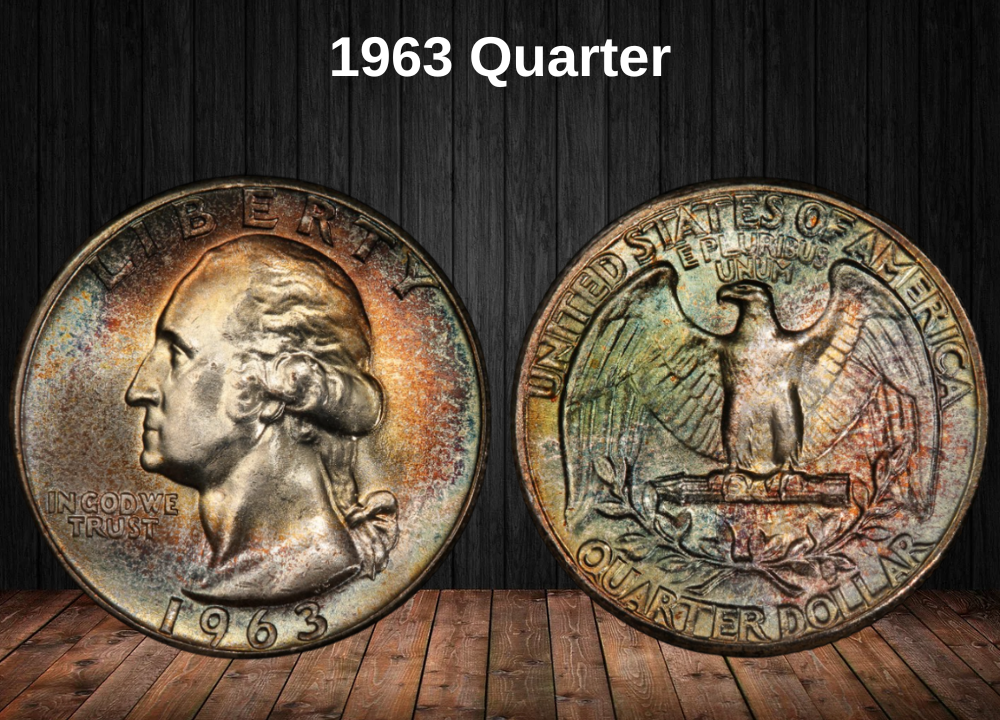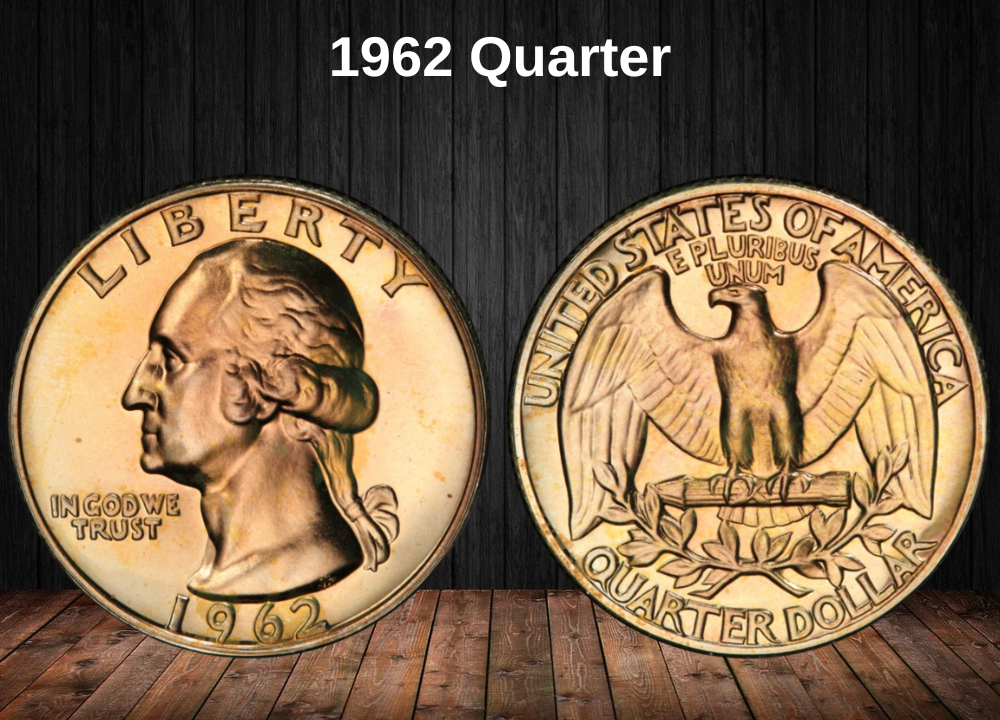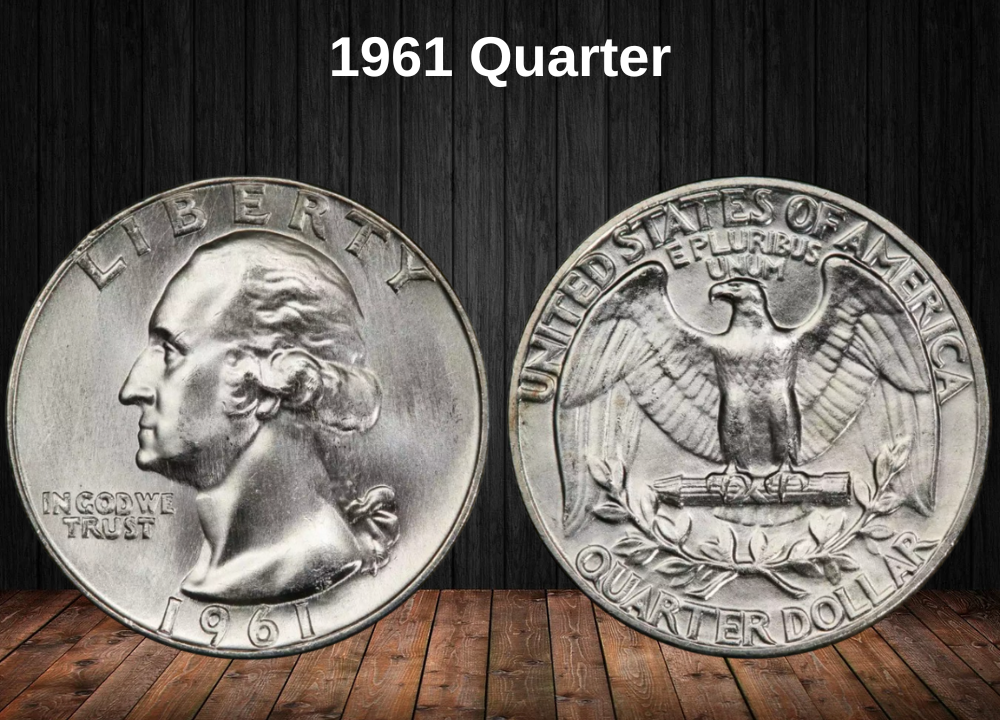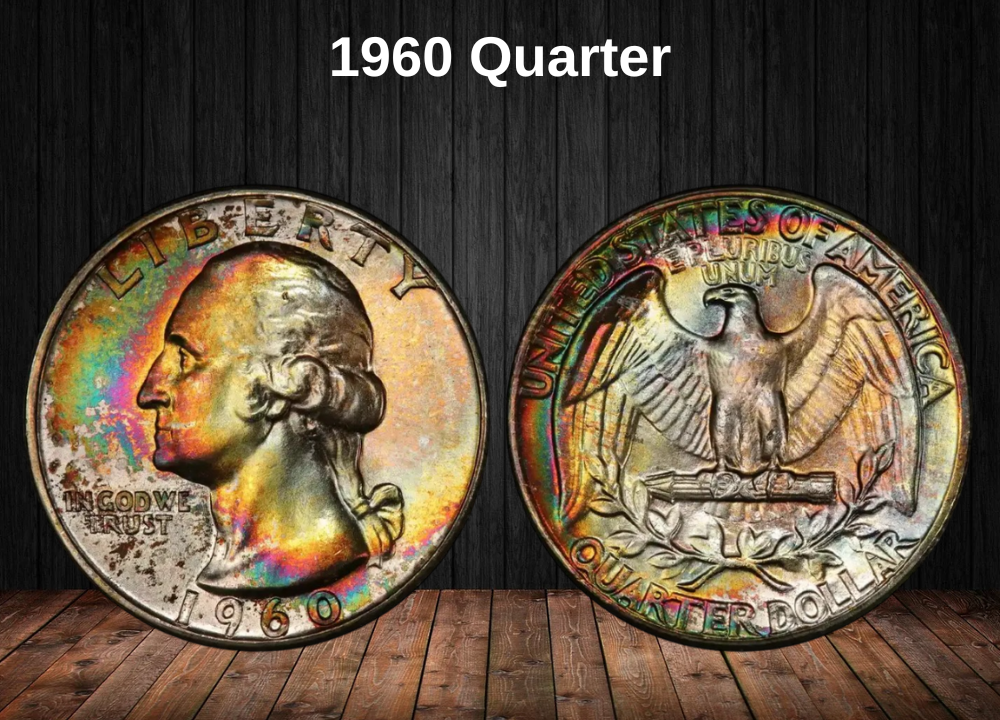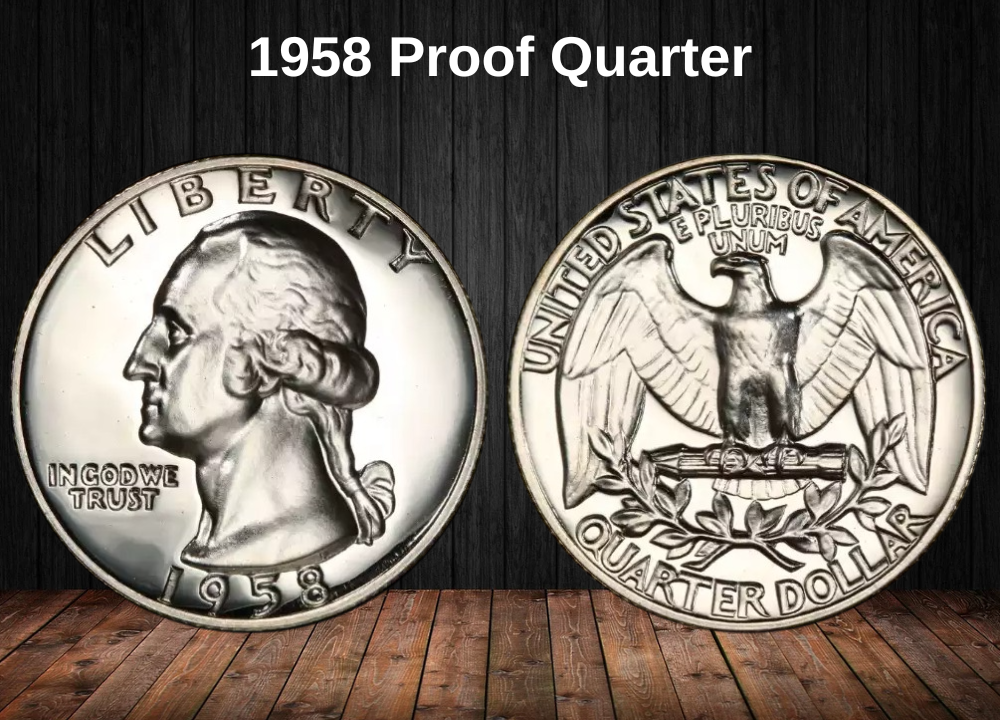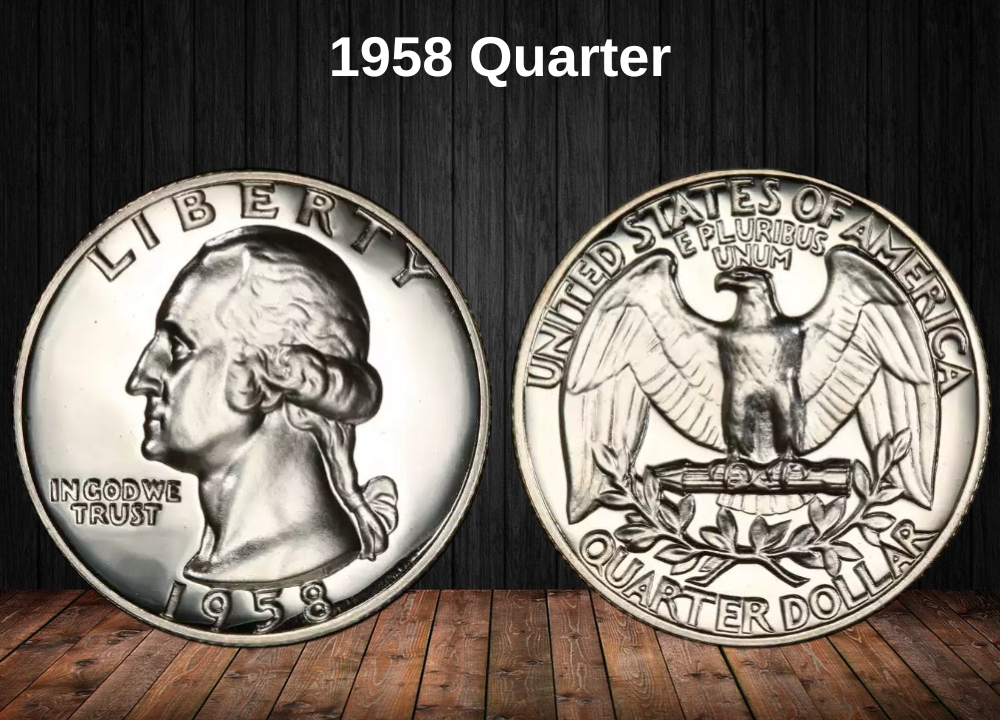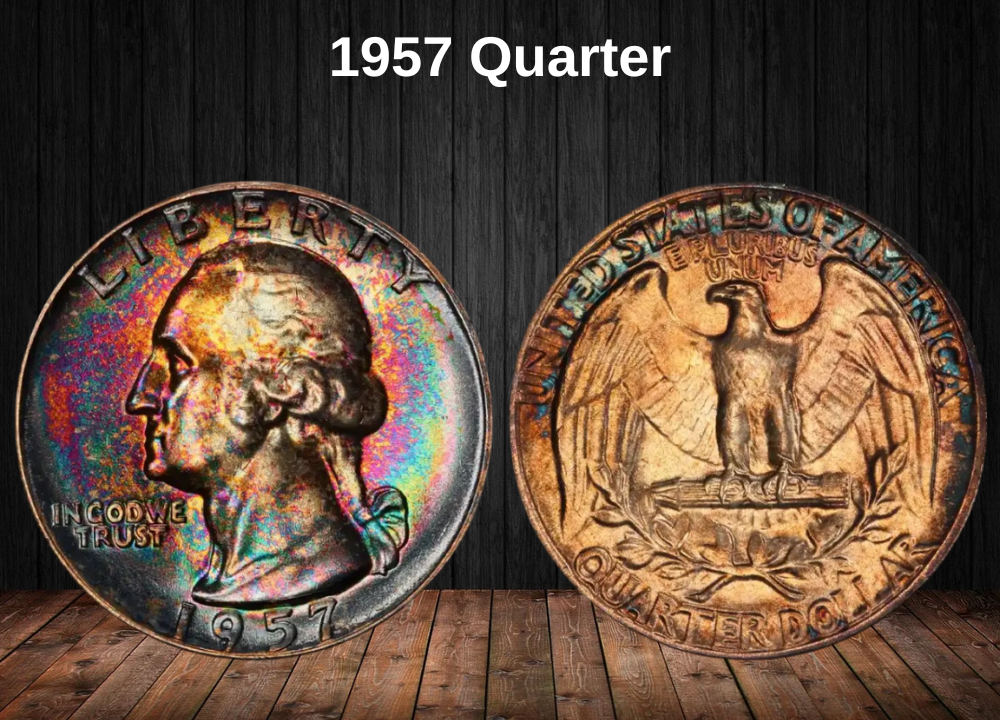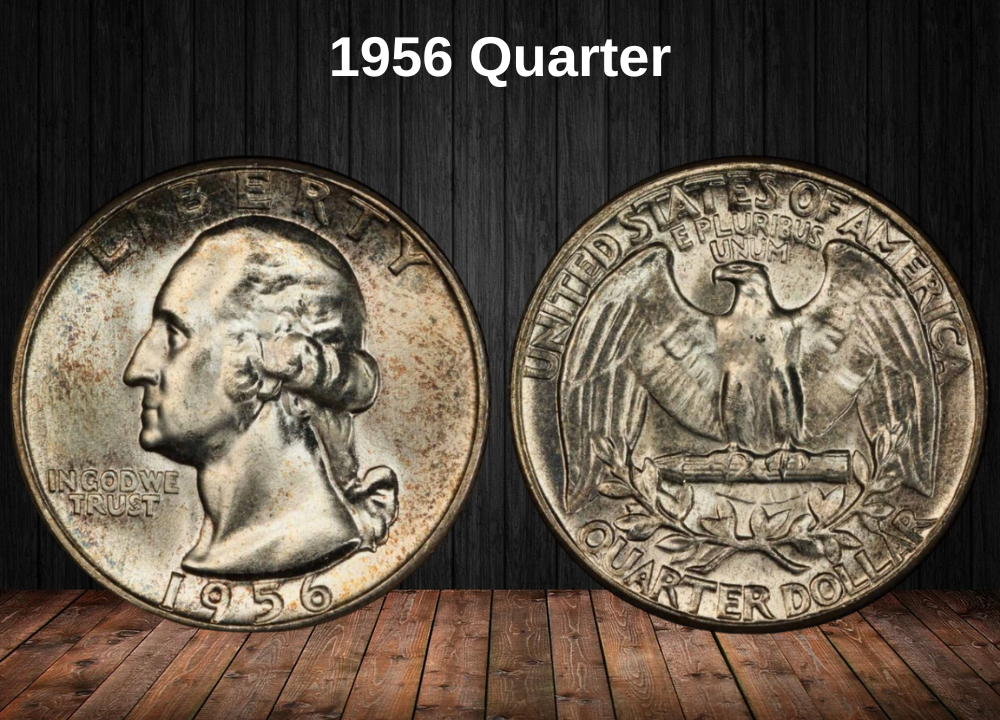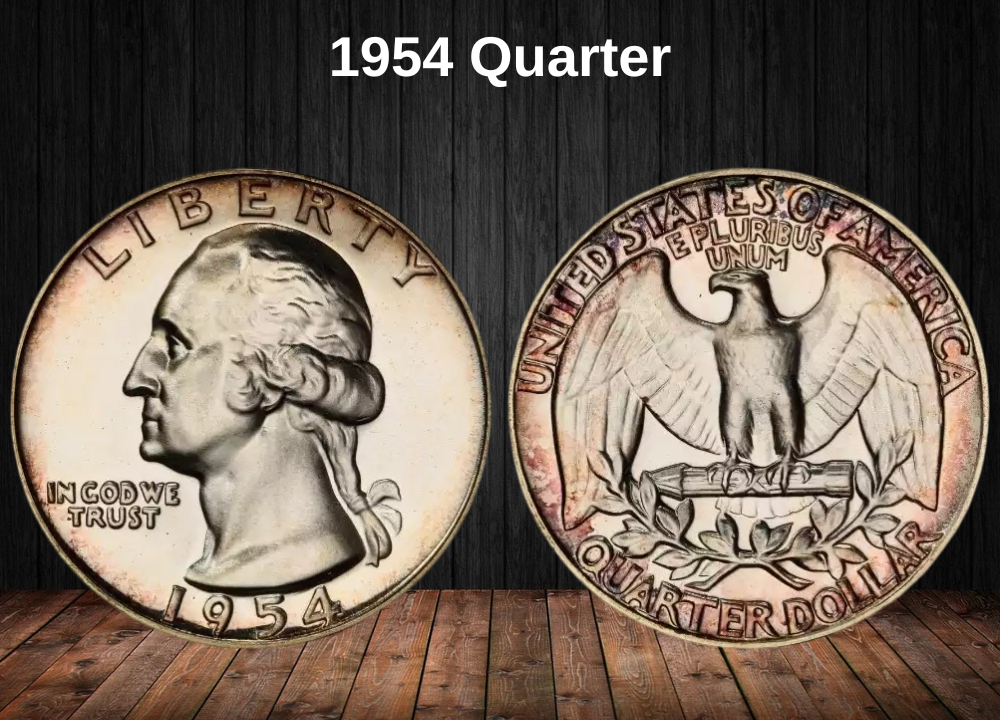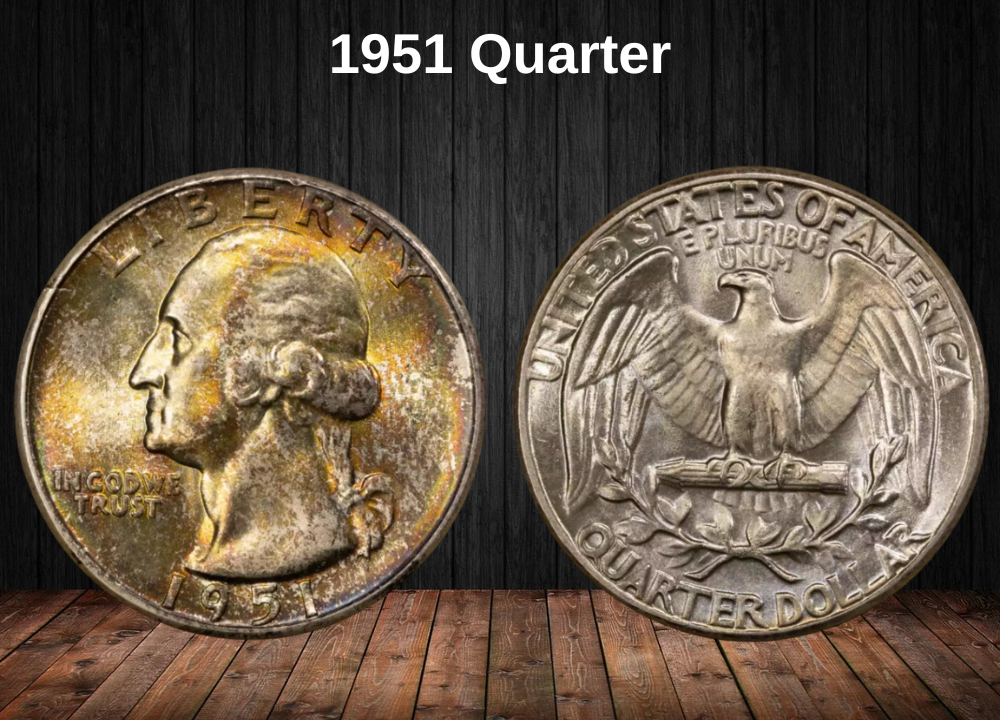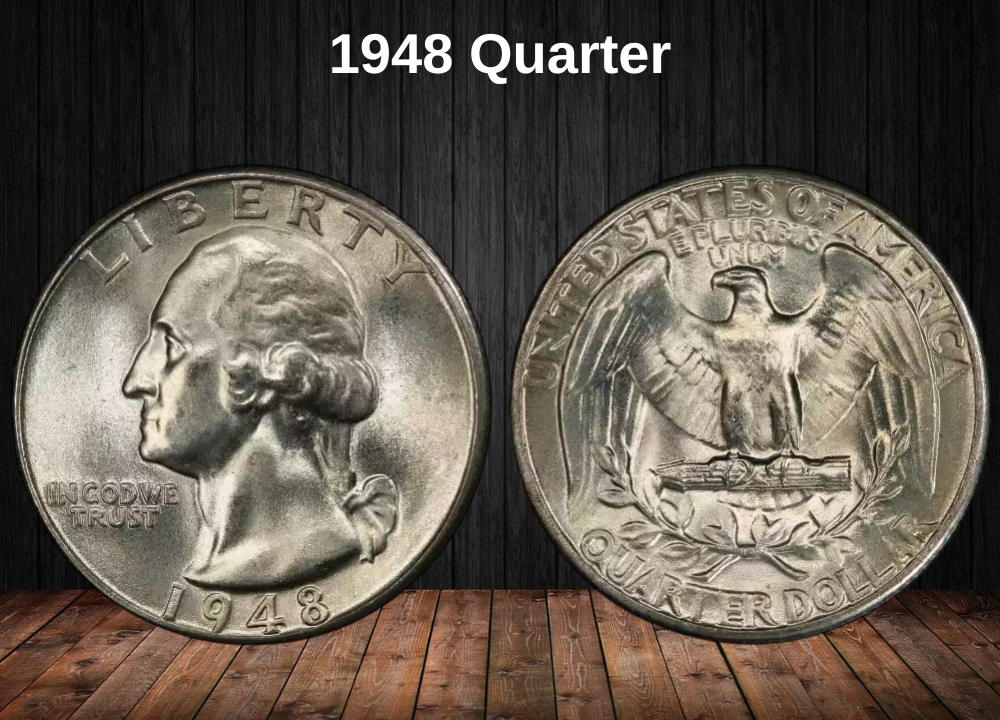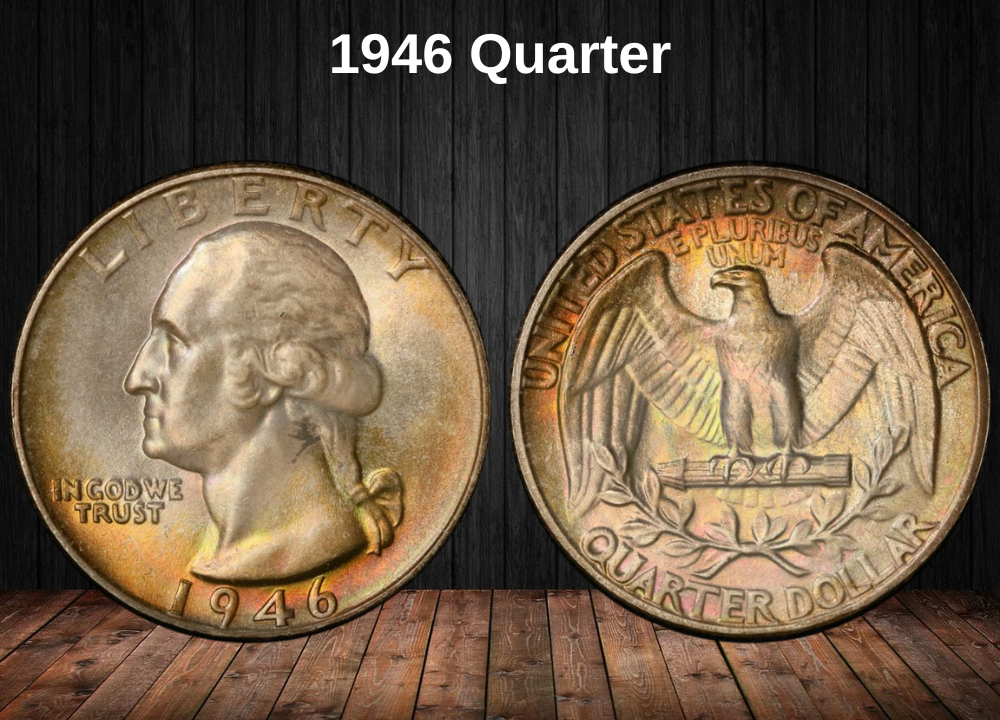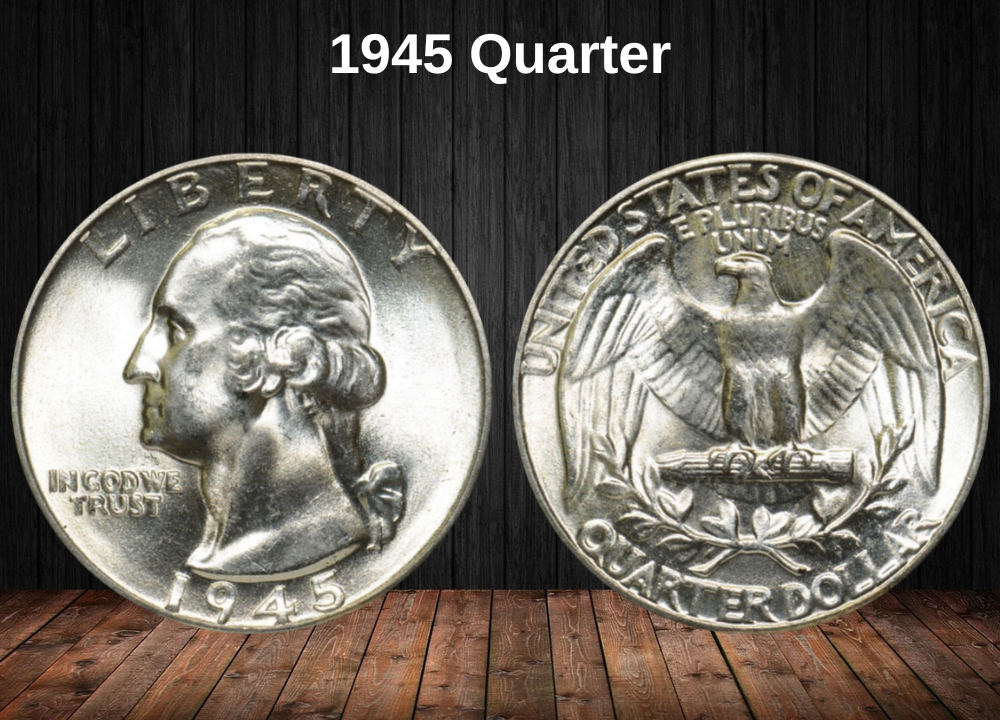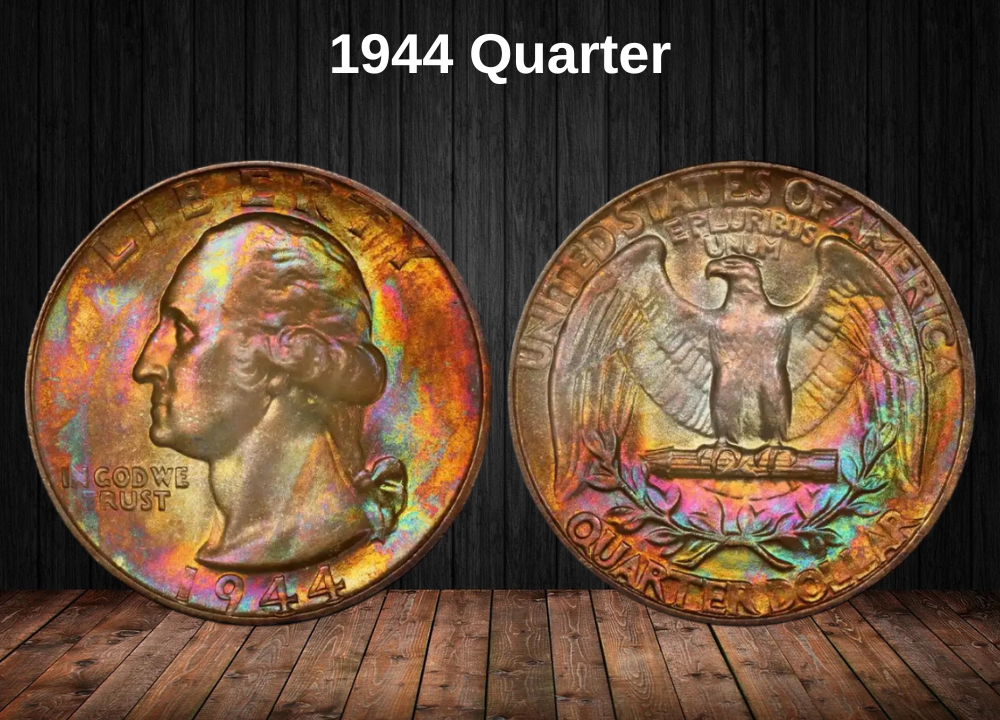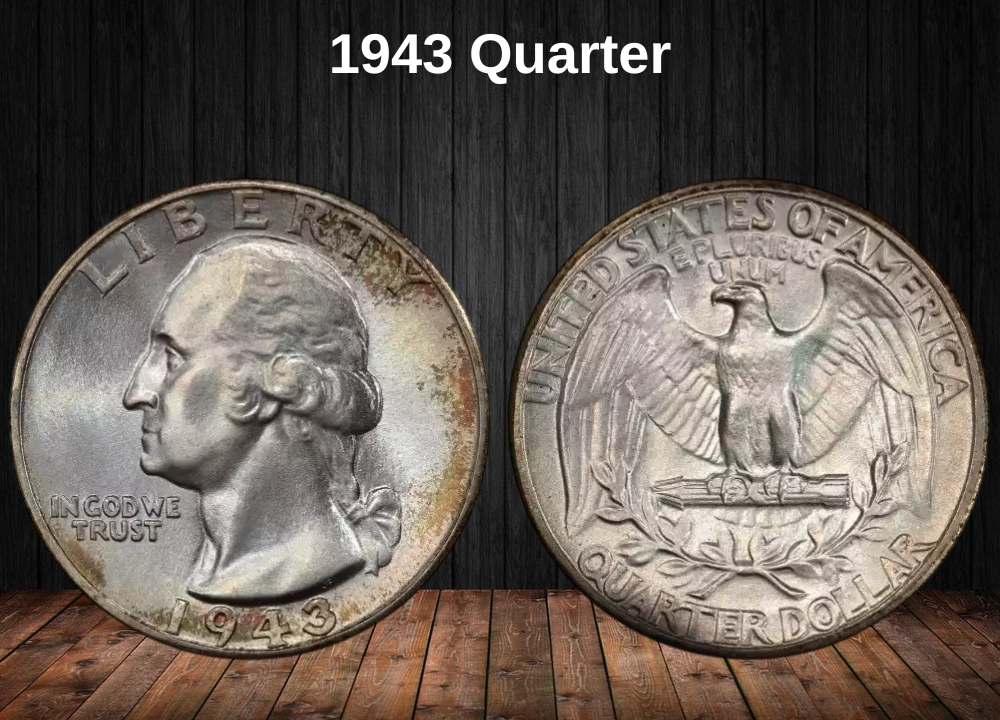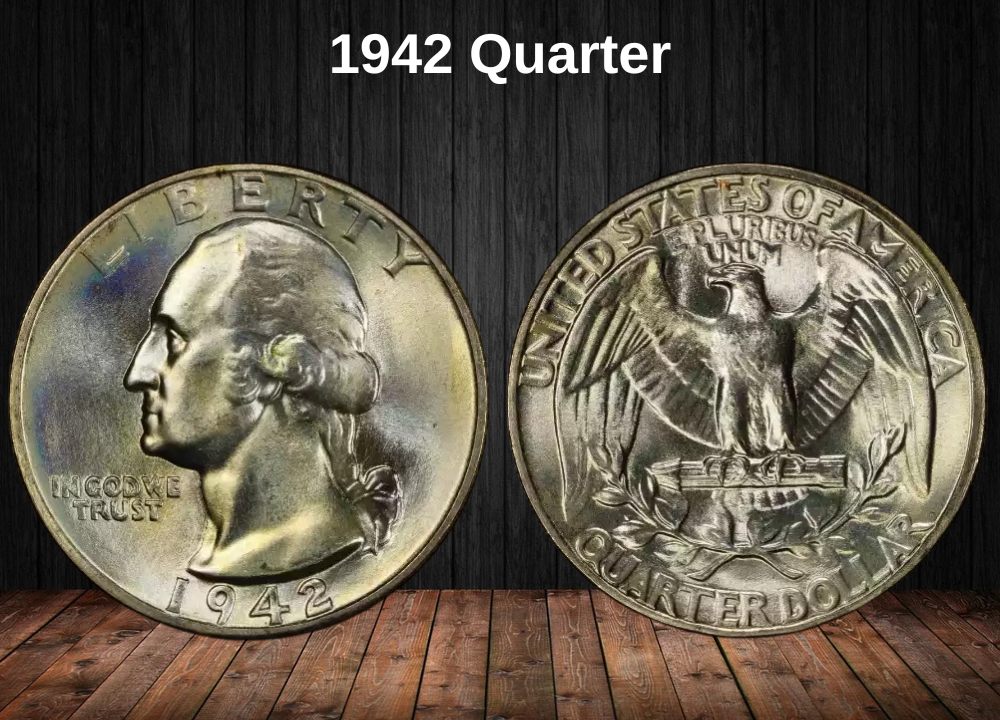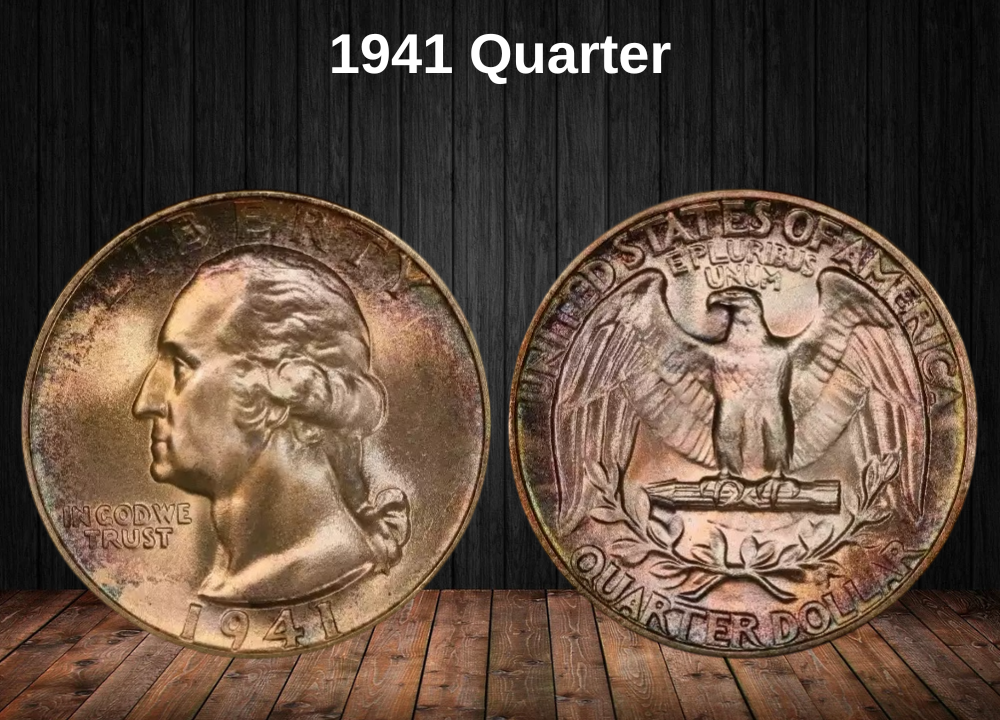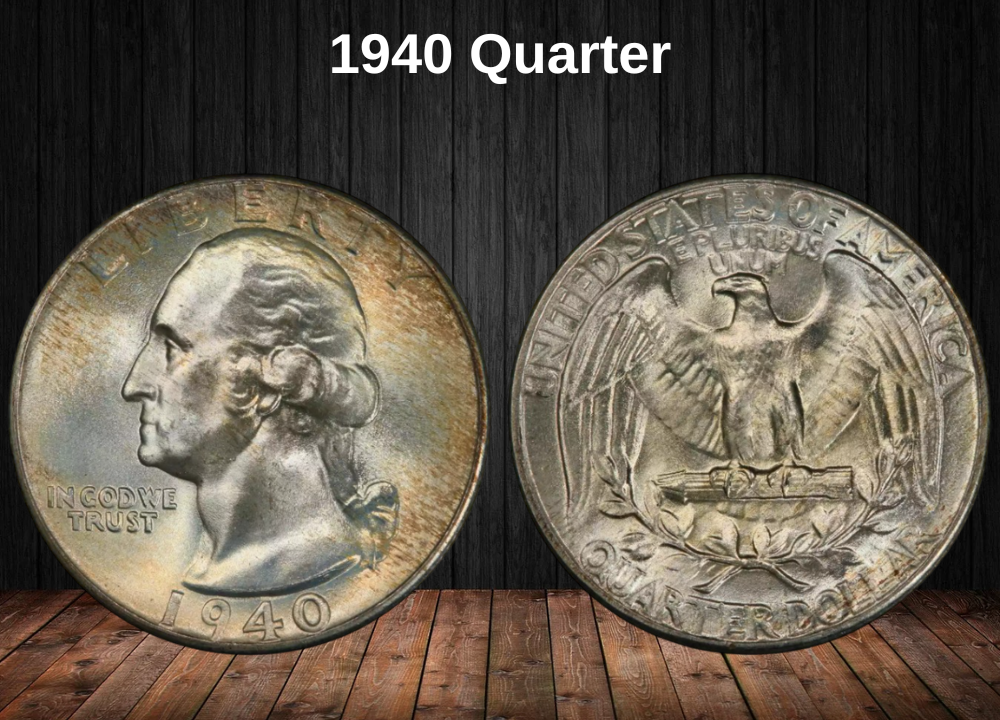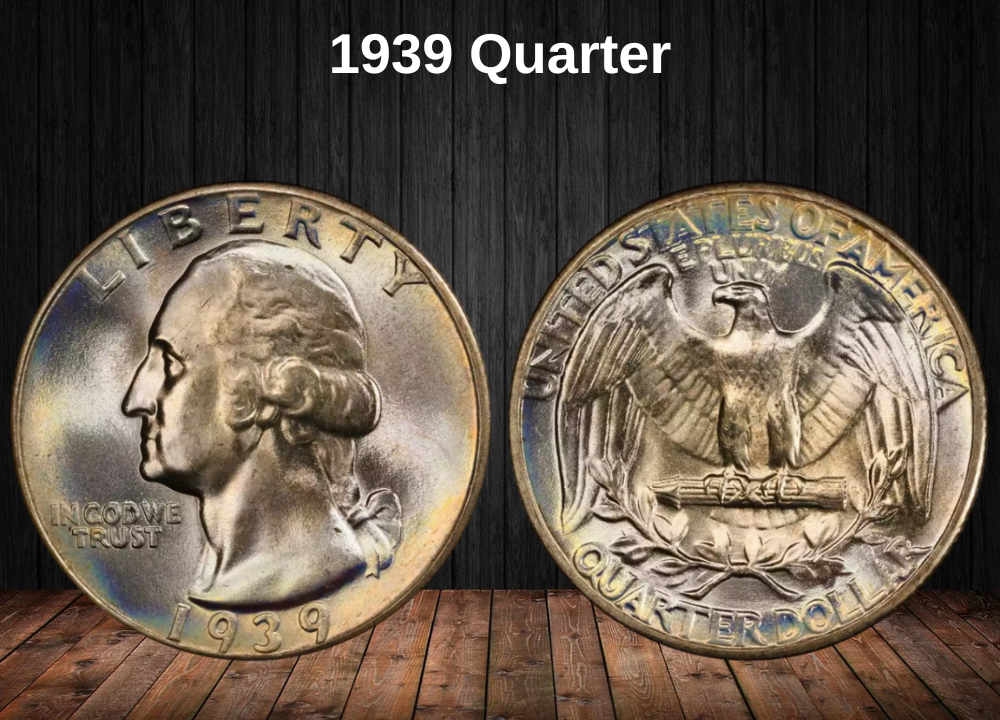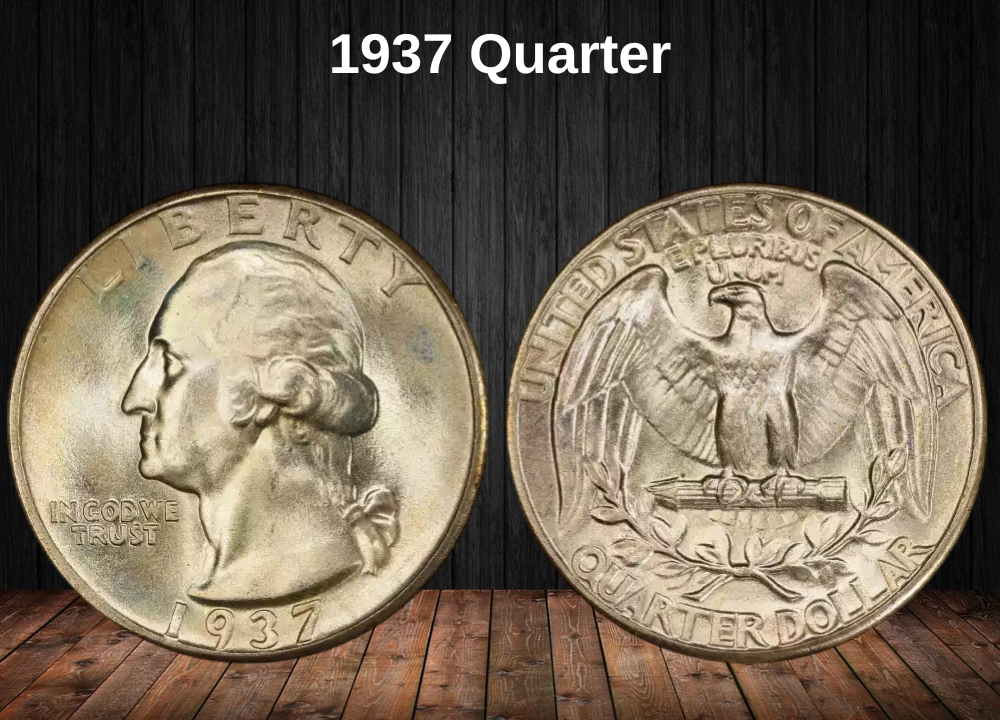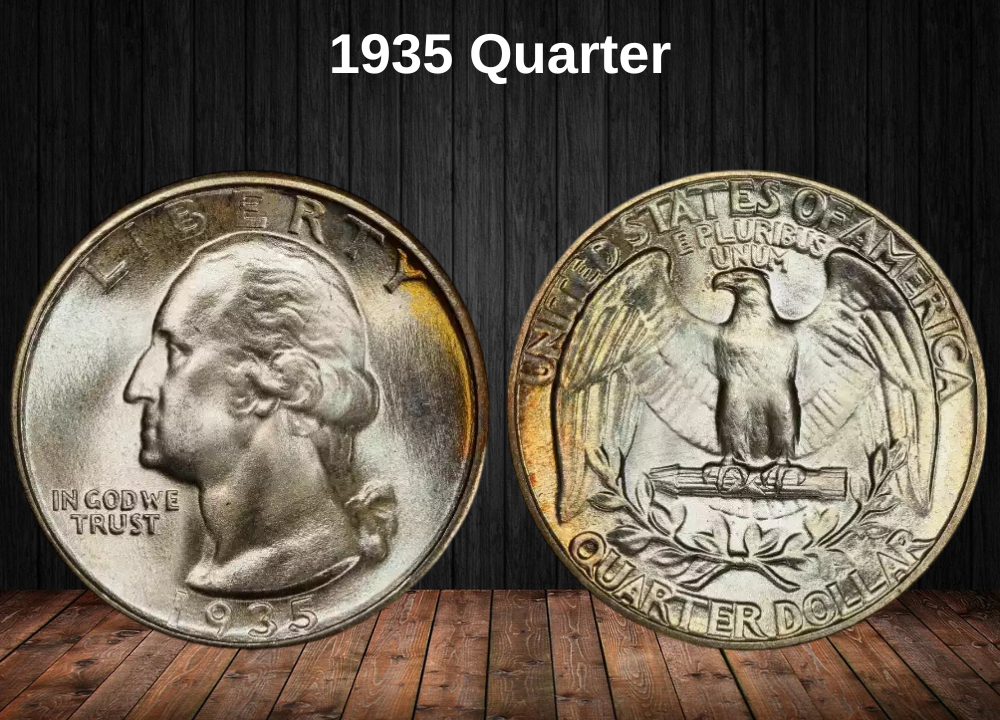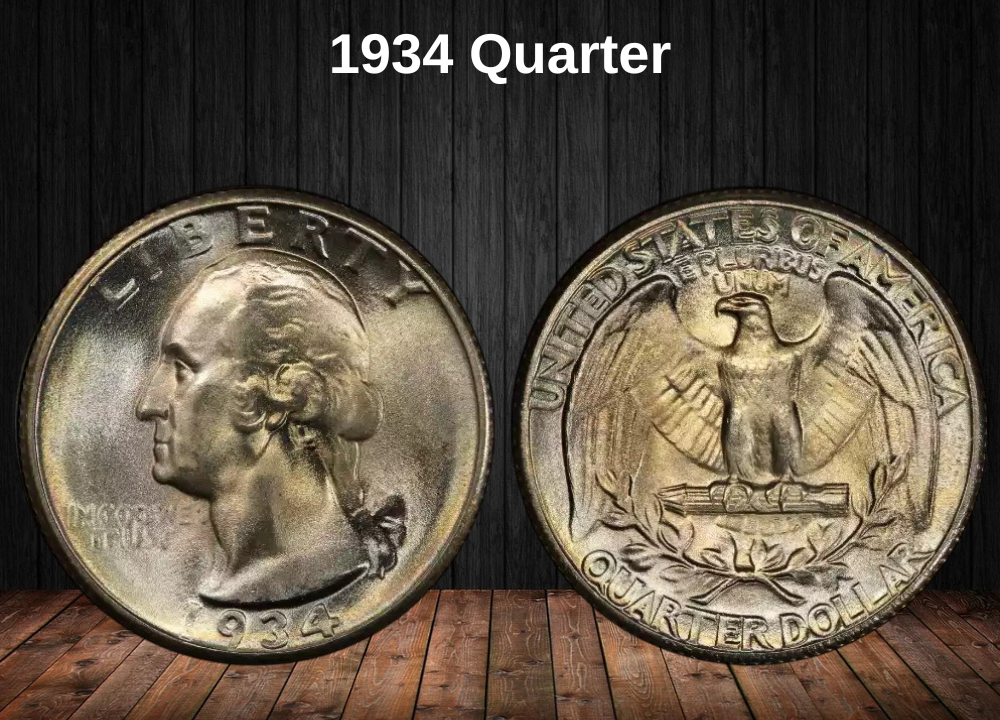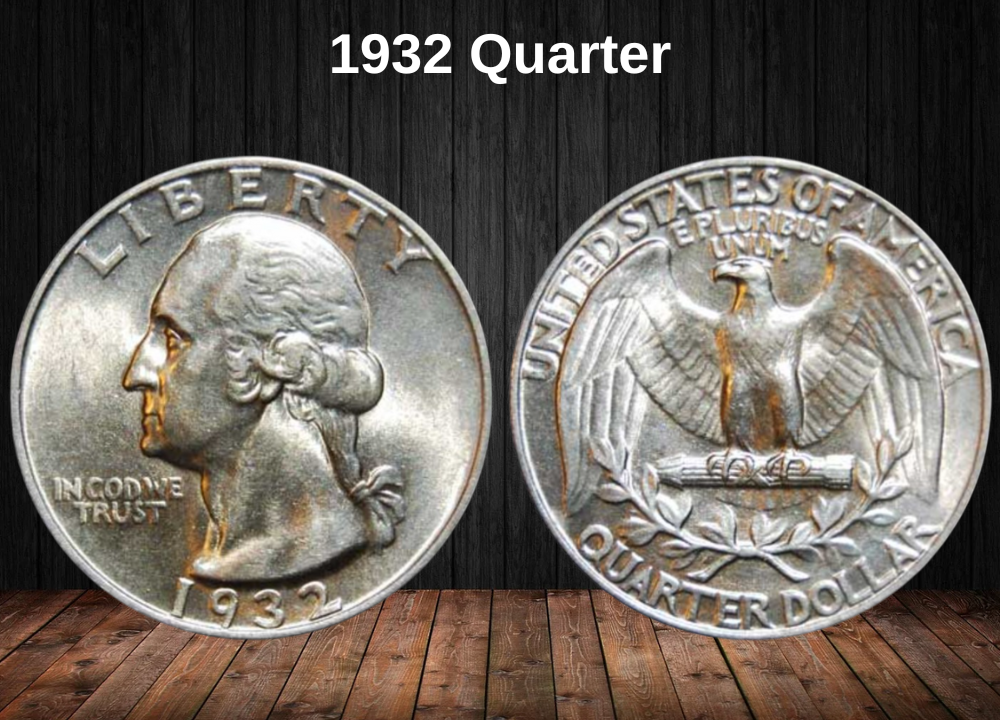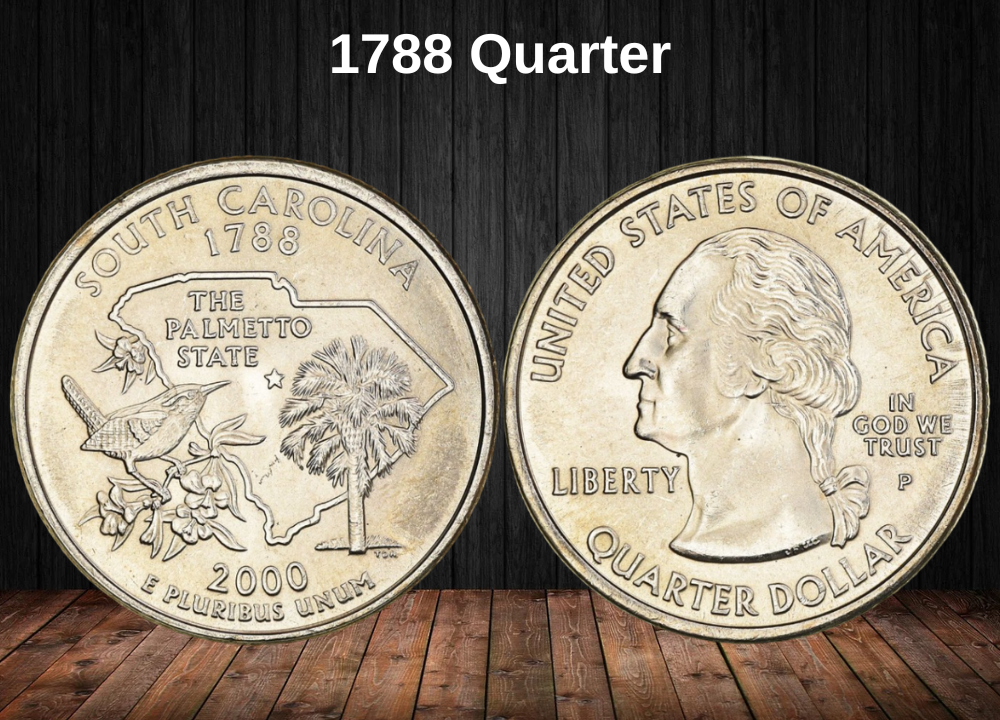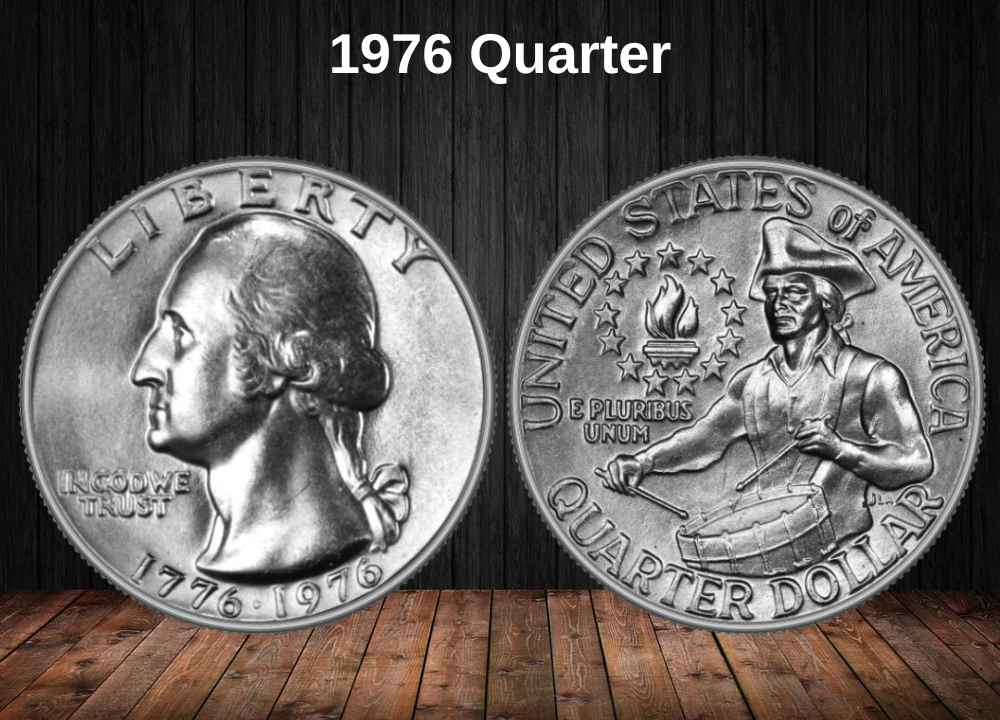The 1950 Washington Quarter marks a turning point in U.S. coinage. Not only is it a standard silver issue from Philadelphia, Denver, and San Francisco, but it also became historically important as the first Proof quarter struck after an eight-year hiatus during World War II.
Business strikes from all three mints remain accessible, generally trading between $6 and $7 in circulated condition. However, Proof coins from 1950 changed the landscape for collectors. With just 51,386 Proof sets minted that year, Cameo (CAM) and especially Deep Cameo (DCAM) examples are now considered trophy coins of the series.
- Standard Proofs: $158+
- Cameo Proofs: $328+
- Deep Cameo Proofs: $3,300+ (fewer than a dozen known)
1950 Quarter Value by Variety
The table below lists current market values across mint marks and conditions:
| Type | Good | Fine | About Uncirculated (AU) | Mint State (MS) | Proof (PR) |
|---|---|---|---|---|---|
| 1950 (No Mint Mark – Philadelphia) | $6.00 | $6.17 | $7.00 | $24.67 | — |
| 1950-D (Denver) | $6.00 | $6.17 | $7.00 | $29.00 | — |
| 1950-S (San Francisco) | $6.00 | $6.17 | $7.00 | $24.50 | — |
| 1950 Proof | — | — | — | — | $158.25 |
| 1950 CAM Proof | — | — | — | — | $328.14 |
| 1950 DCAM Proof | — | — | — | — | $3,354.29 |
History of the 1950 Quarter
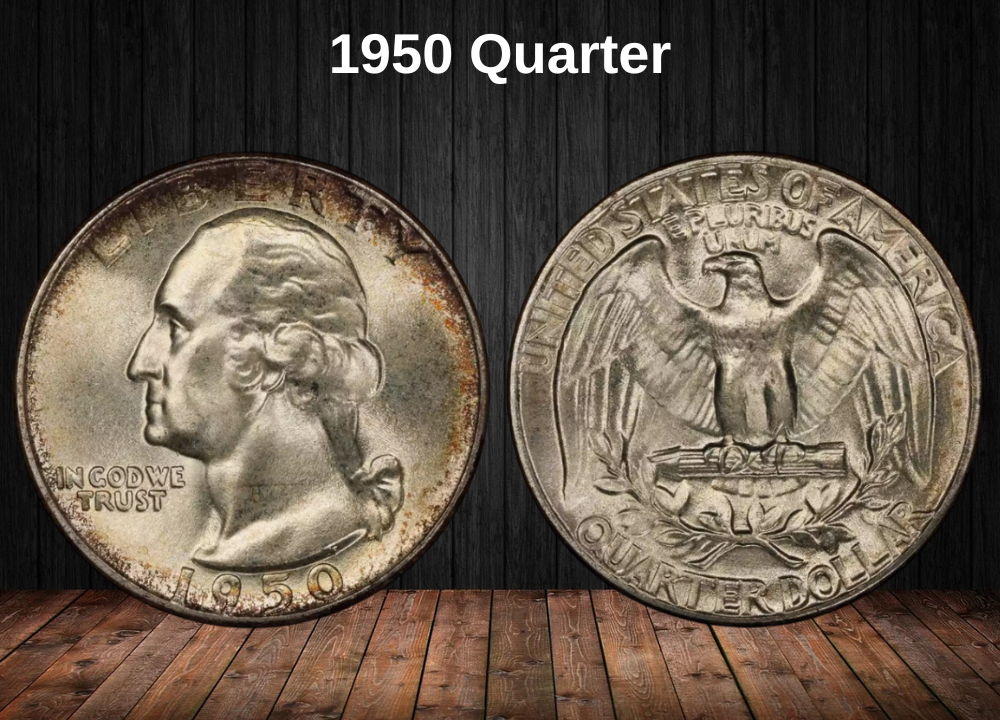
The 1950 Washington Quarter emerged during a pivotal era in American numismatics, symbolizing the nation’s return to peacetime minting after the upheavals of World War II.
From 1943 through 1949, Proof coin production was suspended as the U.S. Mint prioritized wartime needs. Its reintroduction in 1950 marked a milestone, producing just 51,386 Proof coins—a small but historic mintage that instantly elevated the year’s significance.
Mint Production in 1950
- Philadelphia: 24,820,126 business strikes + 51,386 Proofs
- Denver: 21,075,600 quarters
- San Francisco: 10,284,400 quarters
Together, these three facilities struck a broad supply for circulation while cautiously testing the market with Proof coins once again.
Overdate Varieties
The transitional nature of post-war minting also produced two of the most famous Washington quarter errors:
- 1950-D/S: Denver mint mark punched over a San Francisco “S”
- 1950-S/D: San Francisco mint mark punched over a Denver “D”
These overpunch mint mark errors occurred as the Mint reused dies to conserve resources, leaving behind dramatic collector varieties that remain highly sought after today.
The Deep Cameo Proof (DCAM)
Among Proof strikes, the 1950 Deep Cameo (DCAM) quarter represents the pinnacle of rarity and beauty. With fewer than 50 known examples, its sharp contrast between frosted devices and mirrored fields makes it one of the most coveted Washington quarters ever produced.
Key Features of the 1950 Quarter
The 1950 Washington Quarter retained John Flanagan’s classic design, but the year marked a turning point as the U.S. Mint resumed proof coin production after a seven-year suspension during World War II.
All three mints—Philadelphia, Denver, and San Francisco—produced business strikes, while Philadelphia exclusively struck Proof coins. The year also gained importance for its dramatic overdate varieties (D/S and S/D) created during die preparation, adding to collector demand.
Obverse Design
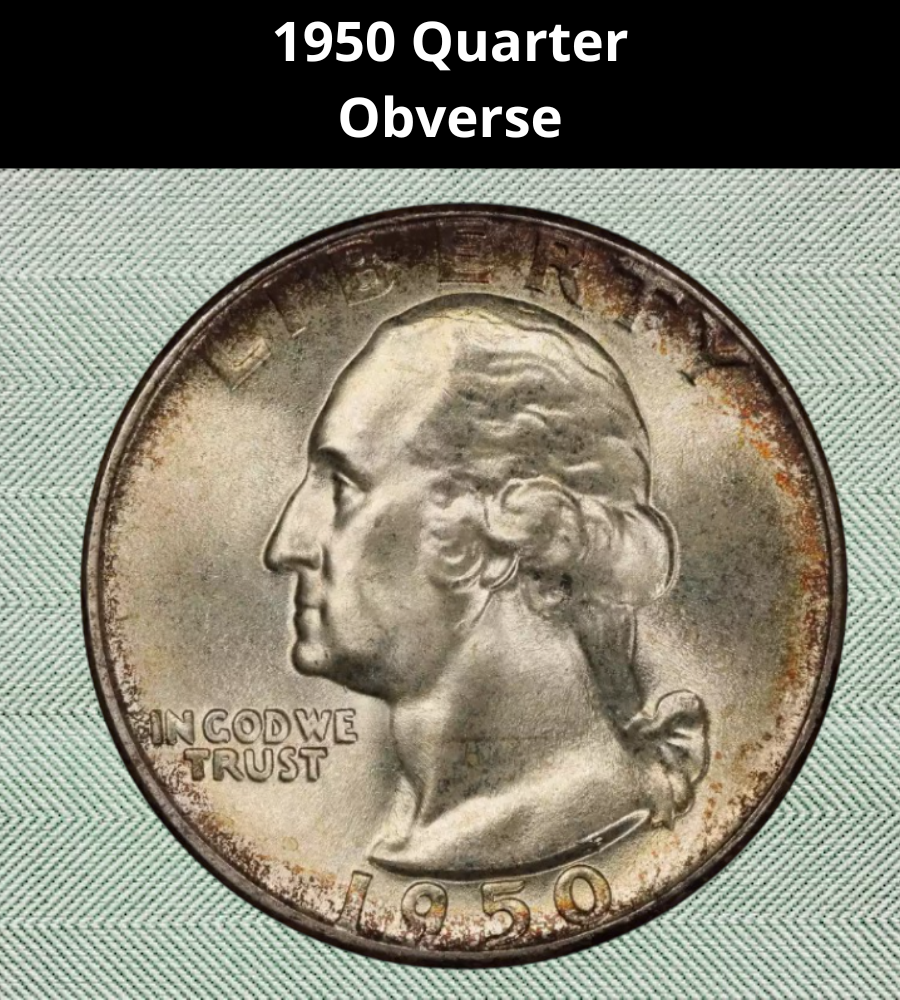
- Portrait of George Washington facing left.
- “LIBERTY” inscribed along the top edge.
- “IN GOD WE TRUST” placed below Washington’s chin.
- The year 1950 at the bottom.
- Designer John Flanagan’s initials “JF” at the base of the neck.
Reverse Design
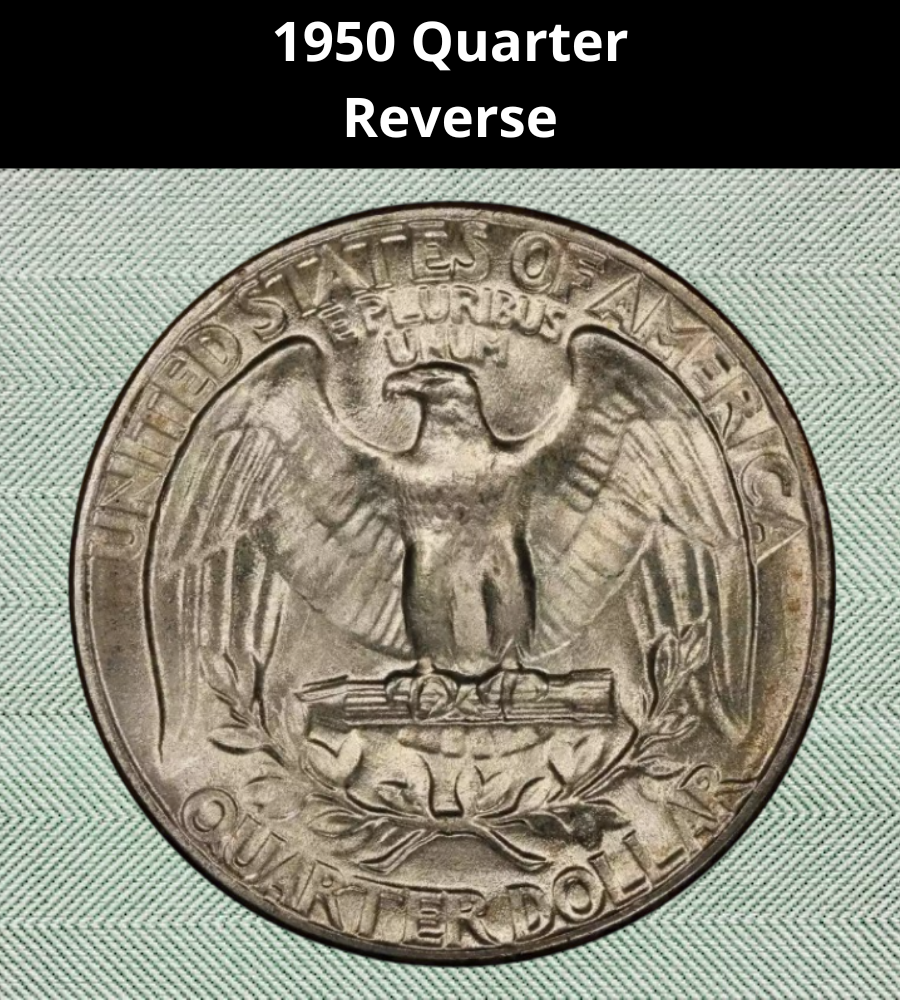
- A heraldic eagle with wings spread wide.
- Eagle clutching arrows (symbolizing strength) in the left talon and an olive branch (peace) in the right.
- “UNITED STATES OF AMERICA” curves along the top rim.
- “E PLURIBUS UNUM” appears above the eagle on a ribbon.
- “QUARTER DOLLAR” at the bottom.
- Mint marks (D, S, or blank for Philadelphia) appear below the wreath bow.
Technical Specifications
- Face Value: $0.25
- Composition: 90% Silver, 10% Copper
- Weight: 6.25 g (0.20094 troy oz)
- Silver Content: 5.62 g (0.1808 troy oz)
- Diameter: 24.3 mm (0.9567 in)
- Thickness: 1.75 mm (0.0687 in)
- Edge: Reeded, with 119 reeds
1950 Quarter Grading Guide
| Grade | Description | Key Details to Check | Approx. Value |
|---|---|---|---|
| Good (G–4) | Heavy wear; design flat | Washington’s hair above ear completely smooth, eagle’s breast flat, legends readable but weak | ~$6 |
| Fine (F–12) | Moderate wear; partial detail | Some curls in Washington’s hair visible, eagle’s wings outlined, legends sharp | ~$6–7 |
| About Uncirculated (AU–50 to AU–58) | Slight wear on high points | Hair detail mostly intact, cheek and jawline defined, eagle’s breast shows light wear, partial luster remains | ~$7–20 |
| Mint State (MS–60 to MS–65) | No wear; some contact marks | Full hair and feather detail visible, luster present but may have bag marks on eagle or fields | ~$25–200+ |
| Gem Mint State (MS–66 to MS–68) | Exceptional strike, sharp details | Fully separated hair curls, crisp eagle feathers, minimal contact marks, strong luster | $400–$3,000+ |
| Proof / CAM / DCAM | Special strikes with mirror fields | Strong contrast between frosted devices and mirrored fields; CAM/DCAM examples extremely scarce | $158 – $3,354+ |
1950 Quarter Value Guides
1950 No Mint Mark Quarter Value
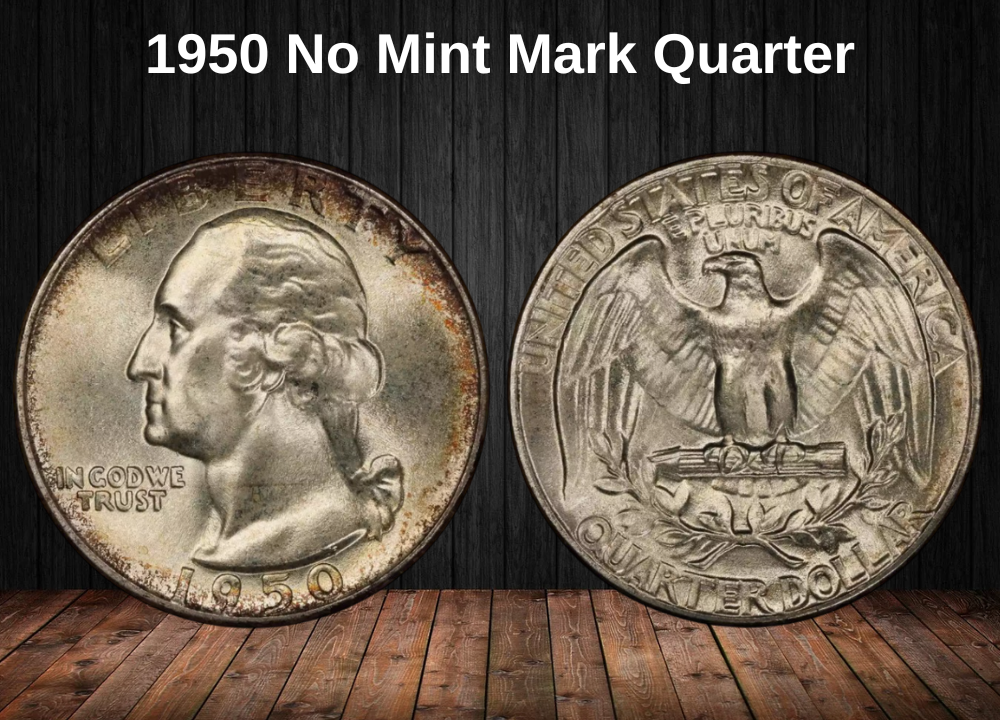
The 1950 No Mint Mark Quarter represents Philadelphia’s return to peacetime production standards. Nearly 25 million coins were struck, with the Philadelphia Mint emphasizing restored quality control after the challenges of wartime coinage.
Despite its substantial mintage, the Philadelphia issue stands out for its exceptional strike quality and lustrous surfaces, hallmarks of the Mint’s renewed commitment to excellence.
What makes this coin especially appealing is its role as an affordable gateway into the complex 1950 Quarter series. While the overdate varieties and Deep Cameo Proofs command extreme premiums, the Philadelphia quarter offers collectors a type coin with sharp details and historical importance at a more accessible price point.
1950 No Mint Mark Quarter Price/Grade Chart
| Grade | Approx. Value | Recent Auction Records |
|---|---|---|
| Good (G–4) | $6 | — |
| Fine (F–12) | $6.17 | — |
| About Uncirculated (AU–50) | $7 | — |
| Mint State (MS–65) | $47 – $240 | Jul 2022 (DL) – MS65, $47; Nov 2022 (HA) – MS67, $240 |
| MS–66 | $56 – $135 | Jun 2022 (DL) – MS66, $56; Sep 2022 (DL) – MS66, $135 |
| MS–67 | $234 – $720 | Apr 2023 (HA) – MS67, $234; Apr 2023 (HA) – MS67, $720 |
| MS–68 | $2,040 – $11,400 | Aug 2022 (SB) – MS68, $2,040; May 2024 (HA) – MS68, $11,400 |
1950-D Quarter Value
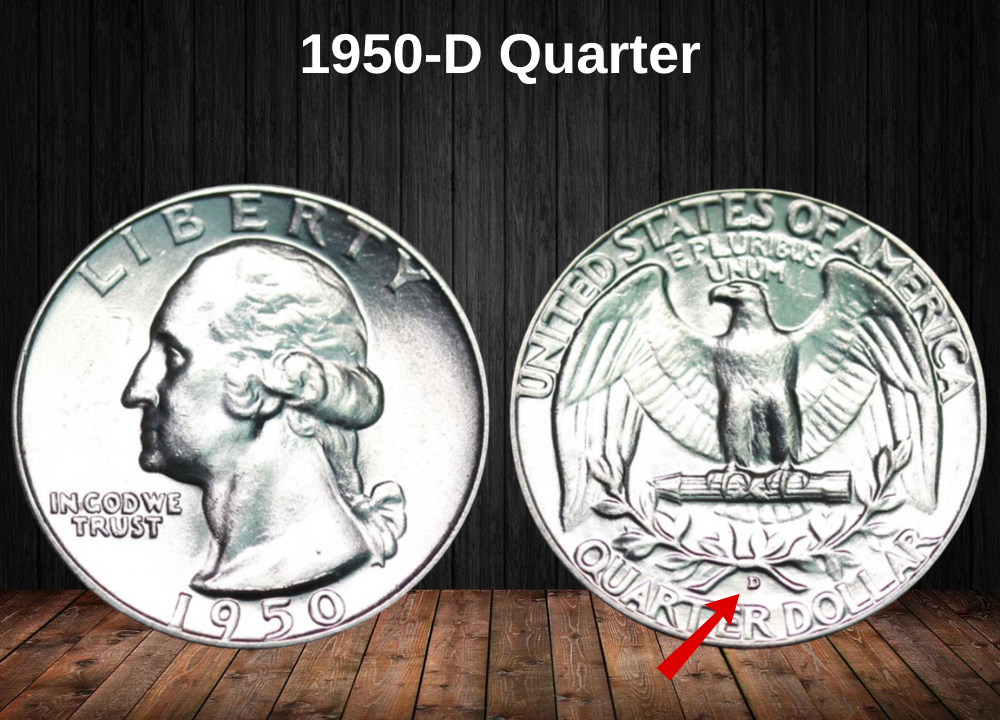
The 1950-D Washington Quarter represents Denver’s strongest post-war production effort, with more than 21 million coins struck under improved quality control standards that rivaled Philadelphia’s output.
This issue illustrates the Denver Mint’s transition from wartime emergency production back to peacetime excellence, producing quarters with consistently sharp strikes and attractive luster. As a result, high-grade survivors are more available compared to earlier 1940s issues.
The Denver issue also holds special significance when contrasted with the famous 1950-D/S overdate error. While the normal Denver strikes embody quality and uniformity, the overpunched mint mark variety remains legendary for its rarity, making the standard 1950-D an essential companion in any complete set.
1950-D Quarter Price/Grade Chart
| Grade | Approx. Value | Recent Auction Records |
|---|---|---|
| Good (G–4) | $6 | — |
| Fine (F–12) | $6.17 | — |
| About Uncirculated (AU–50) | $7 | — |
| Mint State (MS–65) | $35 | Dec 2022 (DL) – MS65, $35 |
| MS–66 | $67 | May 2024 (HA) – MS66, $67 |
| MS–67 | $144 – $4,080 | Aug 2024 (SB) – MS67, $144; Aug 2022 (HA) – MS67, $4,080 |
| MS–67+ (Premiums) | $1,500 – $2,760 | Apr 2023 (DL) – MS67, $1,500; Feb 2024 (HA) – MS67, $2,760 |
1950-S Quarter Value
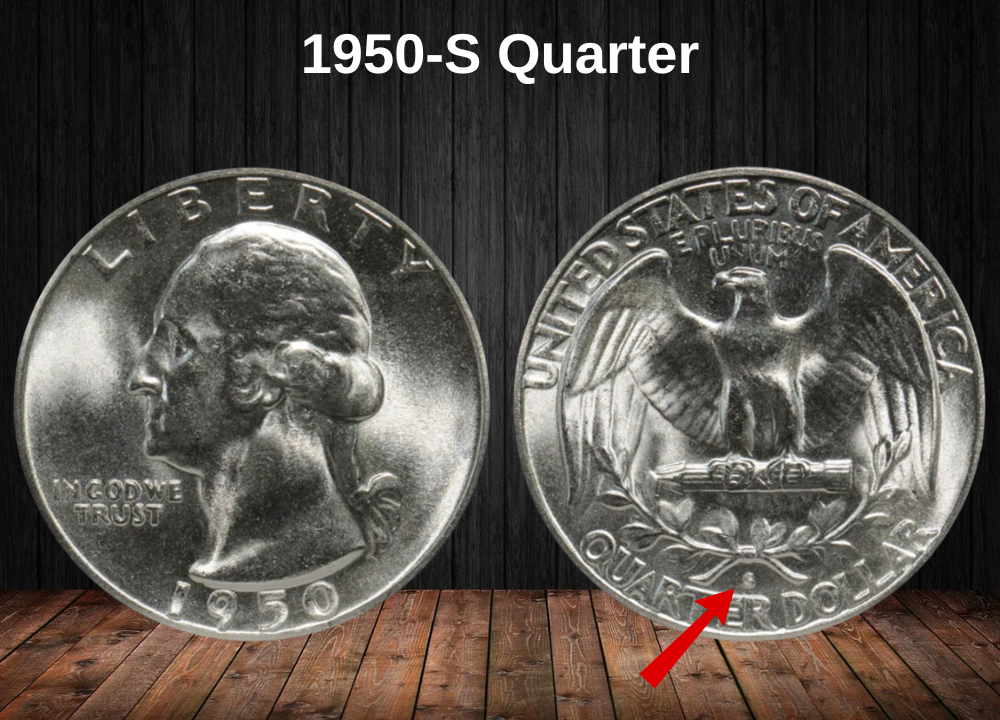
The 1950-S Washington Quarter represents San Francisco’s lowest mintage regular-issue quarter of the early 1950s, with just over 10.2 million coins struck. This production level, though not tiny, was far smaller than Philadelphia’s and Denver’s outputs, adding appeal for collectors.
The San Francisco Mint was renowned for its sharp strikes and clean surfaces during this era, and the 1950-S issue reflects that reputation well.
Its greatest significance, however, lies in its connection to the legendary 1950-S/D overdate error. While the error variety remains one of the most famous in the Washington series, the regular 1950-S serves as its foundation—making both coins historically linked and essential for collectors.
Additionally, the clear and well-placed “S” mint mark below the eagle makes this variety instantly recognizable and a favorite among West Coast mint specialists.
1950-S Quarter Price/Grade Chart
| Grade | Approx. Value | Recent Auction Records |
|---|---|---|
| Good (G–4) | $6 | — |
| Fine (F–12) | $6.17 | — |
| About Uncirculated (AU–50) | $7 | — |
| Mint State (MS–65) | $65 – $180 | Jan 2023 (DL) – MS65, $65; May 2023 (HA) – MS67, $180 |
| MS–66 | $70 – $216 | Jul 2022 (DL) – MS66, $70; Jun 2023 (SB) – MS66, $216 |
| MS–67 | $216 – $280 | Jul 2024 (SB) – MS67, $216; Apr 2023 (DL) – MS67, $280 |
| MS–68 | $5,040 | Jan 2023 (HA) – MS68, $5,040 |
1950 Proof Quarter Value
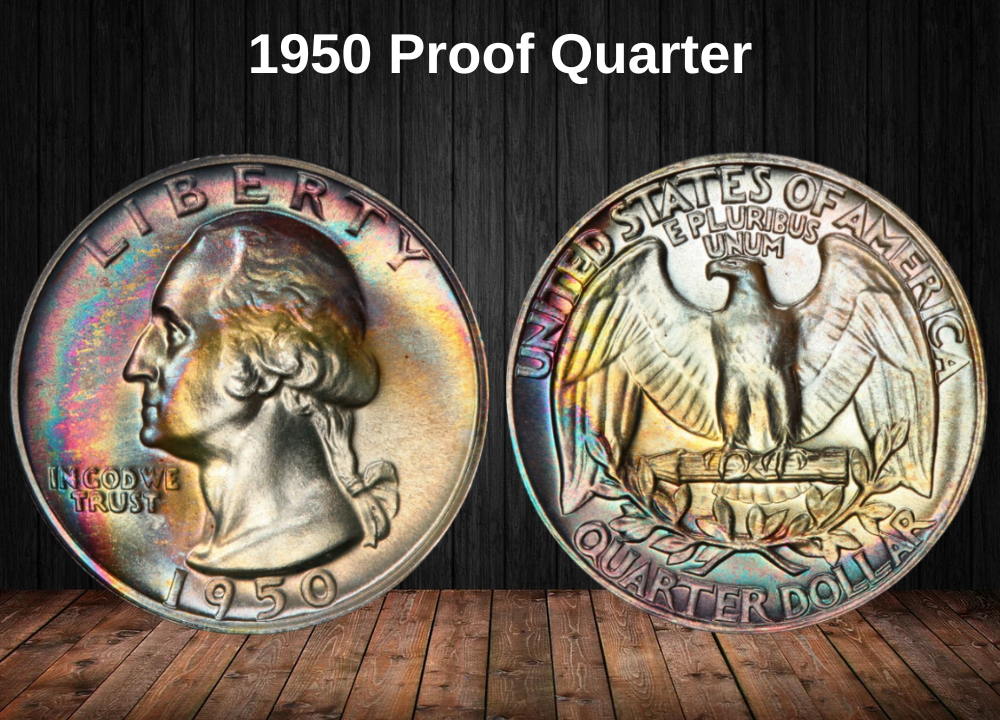
The 1950 Proof Washington Quarter marks a historic milestone as the U.S. Mint’s return to proof coin production after a seven-year wartime suspension (1943–1949).
With only 51,386 coins struck exclusively at the Philadelphia Mint, this Proof issue represents the careful resumption of specialized collector coinage, using restored peacetime standards of precision and quality.
What makes the 1950 Proof especially significant is its role as the foundation of the modern proof program. Its mirror-like fields and razor-sharp strikes signaled the Mint’s renewed commitment to craftsmanship. This coin also serves as the base for Cameo and Deep Cameo designations, which command exponentially higher premiums.
1950 Proof Quarter Price/Grade Chart
| Grade | Approx. Value | Recent Auction Records |
|---|---|---|
| PR64 | $59 | Jun 2023 (HA) – PR64, $59 |
| PR65 | $85 – $151 | Nov 2024 (SB) – PR65, $85; Apr 2023 (DL) – PR67, $151 |
| PR66 | $61 | May 2023 (HA) – PR66, $61 |
| PR67 | $89 – $336 | Feb 2023 (HA) – PR67, $89; Apr 2023 (SB) – PR67, $336 |
| PR68 | $1,020 | Apr 2025 (SB) – PR68, $1,020 |
1950 CAM Quarter Value
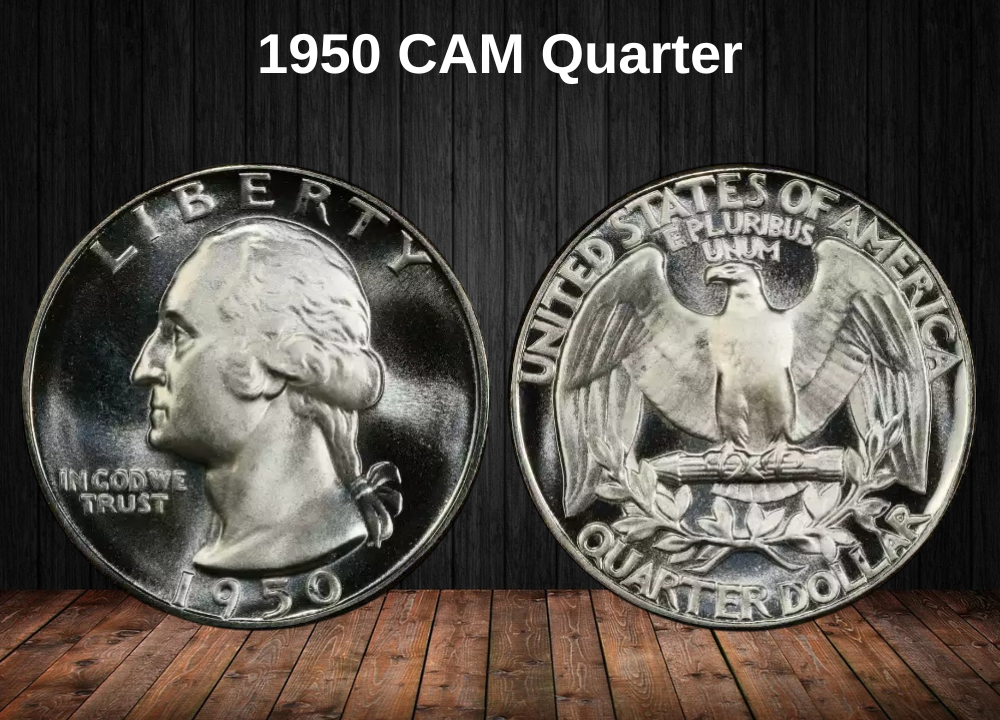
The 1950 CAM (Cameo) Proof Quarter is a showpiece of post-war proof craftsmanship: frosted devices against mirror fields create the classic high-contrast “cameo” look. From the 51,386 Proof quarters struck in 1950, only an estimated ~2,000 qualify for the Cameo designation—an occurrence rate of ~3.89%, which keeps demand intense but attainable for serious collectors.
Why it matters
- Visual impact: Bold frost on Washington and the eagle delivers that 3D “pop.”
- True scarcity: Low CAM rate within a small Proof mintage.
- Market sweet spot: Meaningful premiums without DCAM’s ultra-rarity price wall.
1950 CAM Quarter Price/Grade Chart
(Latest auction records included)
| Grade | Typical Market Range | Select Recent Auction Records |
|---|---|---|
| PR65 CAM | $200 – $300+ | 06/21 HA $204 • 03/21 HA $240 • 12/20 DL $275 • 11/20 DL $280 |
| PR66 CAM | $125 – $300+ | 11/22 HA $222 • 11/22 HA $124 • 12/20 HA $288 |
| PR67 CAM | $650 – $900+ | 11/22 HA $900 • 08/21 SB $660 |
| PR68 CAM | $2,700 – $2,800+ | 01/21 HA $2,760 |
1950 DCAM Quarter Value
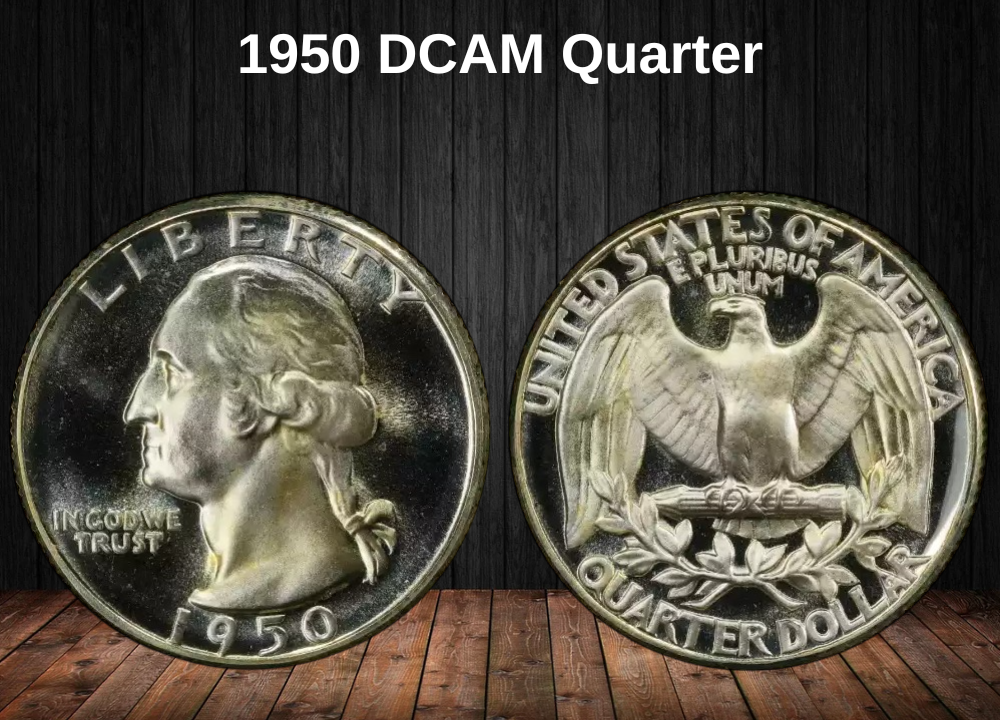
The 1950 DCAM (Deep Cameo) Proof Quarter represents the pinnacle of U.S. proof coin production. It features maximum contrast—with deeply frosted devices that stand in sharp relief against mirror-like fields—creating an almost three-dimensional effect.
Out of the original 51,386 Proof quarters struck in 1950, only about 1,500 examples qualify for the coveted DCAM designation, a survival rate of just 2.92%. This makes the 1950 DCAM one of the rarest Washington Quarters ever produced.
The Philadelphia Mint’s ability to achieve such striking depth and clarity so soon after resuming proof production is a testament to its craftsmanship. For collectors, the 1950 DCAM quarter is both a condition rarity and a visual masterpiece—a true trophy coin in American numismatics.
1950 DCAM Quarter Price/Grade Chart
| Grade | Typical Value Range | Select Auction Records |
|---|---|---|
| PR64 DCAM | $1,500 – $1,800 | Jan 2021 (HA) – $1,680 |
| PR65 DCAM | $2,300 – $3,000 | Dec 2021 (HA) – $2,892 • Jan 2021 (HA) – $2,880 • Mar 2018 (HA) – $2,340 • Jul 2017 (HA) – $2,585 |
| PR66 DCAM | $3,000 – $4,000 | Apr 2017 (HA) – $3,055 • Aug 2012 (SB) – $3,854 |
| PR68 DCAM | $22,000 – $31,000+ | Jun 2023 (SB) – $22,800 • Jan 2022 (HA) – $31,200 |
Rare 1950 Quarter Error List
1. 1950 DDR FS-801 Errors
The 1950 DDR (Doubled Die Reverse) FS-801 is one of the most dramatic error varieties of the Washington Quarter series. This variety displays clear doubling on the reverse inscriptions, most prominently in:
- “UNITED STATES OF AMERICA”
- “QUARTER DOLLAR”
The doubling creates a shadow-like separation in the letters, easily visible under moderate magnification. The strongest examples show distinct splits in the rim lettering, making this error highly collectible.
This occurred during die preparation at the Philadelphia Mint when the reverse working die was misaligned during multiple impressions from the master hub. The FS-801 attribution refers specifically to this bold and well-recognized doubling pattern, distinguishing it from less prominent DDRs.
1950 DDR FS-801 Price/Grade Chart
| Grade | Approx. Value | Notes |
|---|---|---|
| Fine (F–12) | $50 – $75 | Doubling visible but worn |
| About Uncirculated (AU–50) | $150 – $250 | Clear doubling, partial luster |
| Mint State (MS–63) | $350 – $600 | Strong doubling, good eye appeal |
| MS–65 | $1,000 – $1,600 | Registry-quality, scarce |
| MS–66 and above | $2,000+ | Rare, dramatic doubling with minimal marks |
2. 1950-D DDR Errors (FS-801 and FS-802)
The 1950-D Doubled Die Reverse (DDR) errors represent some of the most intriguing Denver Mint varieties of the Washington Quarter series. These coins show clear doubling on the reverse design elements, especially in:
- “UNITED STATES OF AMERICA”
- “QUARTER DOLLAR”
- The eagle’s wings and breast features
FS-801
- Doubling is most evident in the upper rim lettering.
- Letters show shadowing and partial separation under magnification.
FS-802
- Doubling appears more strongly in the lower inscriptions and eagle details.
- Creates a more dramatic three-dimensional look in affected areas.
Both varieties were caused by misaligned hub impressions during die preparation, a process error that produced visible doubling patterns. Because the strength of the doubling varies across individual coins, attribution requires careful inspection under magnification.
1950-D DDR Price/Grade Chart
| Grade | FS-801 Approx. Value | FS-802 Approx. Value | Notes |
|---|---|---|---|
| Fine (F–12) | $40 – $75 | $50 – $80 | Doubling faint but present |
| About Uncirculated (AU–50) | $125 – $200 | $150 – $225 | Clear rim or eagle doubling |
| Mint State (MS–63) | $300 – $450 | $350 – $500 | Collectible Denver DDRs |
| MS–65 | $750 – $1,100 | $900 – $1,300 | Registry demand strong |
| MS–66 and above | $1,800+ | $2,000+ | Rare, with sharp doubling |
3. 1950-D/D RPM FS-501 Errors
The 1950-D/D Repunched Mint Mark (RPM) FS-501 is a classic Denver Mint variety that highlights the manual nature of mint mark application in the early 1950s. This error features a “D” mint mark punched more than once, with the impressions slightly offset from one another.
The result is a visible doubling or “shadow” effect within the mint mark itself. Collectors can see traces of the original “D” alongside the final impression, usually with the help of a loupe or moderate magnification.
This error occurred when the initial punch was either too weak or misaligned, requiring a second strike. Unlike the bold overdate errors, the FS-501 is subtler, but it remains an important variety for mint mark specialists and Washington Quarter collectors alike.
1950-D/D RPM FS-501 Price/Grade Chart
| Grade | Approx. Value | Notes |
|---|---|---|
| Fine (F–12) | $20 – $35 | Doubling faint but present |
| About Uncirculated (AU–50) | $60 – $100 | Clear secondary punch visible |
| Mint State (MS–63) | $150 – $250 | Strong “shadow D” under magnification |
| MS–65 | $350 – $600 | Popular among RPM variety collectors |
| MS–66 and above | $1,000+ | Rare, high-grade examples with sharp RPM |
4. 1950-D/S Errors
The 1950-D/S Washington Quarter is one of the most famous overmintmark (OMM) errors of the series. In this variety, a Denver “D” mintmark was punched directly over a San Francisco “S”.
This error happened when dies originally prepared for the San Francisco Mint were later repurposed at Denver. As a result, the underlying “S” remains partially visible beneath the “D,” producing a distinctive and collectible doubled appearance.
Because the overpunching is clearly identifiable under magnification, the 1950-D/S has become a classic variety among Washington Quarter specialists. Its rarity and striking visual evidence of the minting mistake allow it to command strong premiums at auction.
1950-D/S Price/Grade Chart
| Grade | Approx. Value | Notes |
|---|---|---|
| Fine (F–12) | $50 – $100 | “S” visible under magnification |
| About Uncirculated (AU–50) | $200 – $350 | Good luster with clear overpunch |
| Mint State (MS–63) | $600 – $900 | Strong detail, “S” bold under “D” |
| MS–65 | $1,500 – $2,500 | Registry-quality coins, scarce |
| MS–66 and above | $3,500 – $5,000+ | Rare, high-grade survivors command record prices |
5. 1950-D/S OMM FS-601 Errors
The 1950-D/S Over Mint Mark (OMM) FS-601 is a subtle yet historically important Denver variety. Unlike the more dramatic 1950-D/S where both the “D” and underlying “S” remain visible, the FS-601 variety shows a Denver “D” struck over a San Francisco “S” that had been intentionally removed.
During die preparation, the San Francisco mint mark was ground or filed away before the Denver “D” was applied. This left faint traces or ghost impressions of the original “S,” visible only under magnification.
The FS-601 designation provides the exact diagnostic markers for this repurposed die, making proper attribution essential for collectors who want to distinguish it from other OMM varieties of the year.
1950-D/S OMM FS-601 Price/Grade Chart
| Grade | Approx. Value | Notes |
|---|---|---|
| Fine (F–12) | $40 – $70 | Underlying “S” faint, visible under magnification |
| About Uncirculated (AU–50) | $125 – $225 | Ghost impressions stronger with partial luster |
| Mint State (MS–63) | $300 – $500 | Clear attribution with Denver “D” well struck |
| MS–65 | $900 – $1,500 | Scarce; premium quality coins highly desirable |
| MS–66 and above | $2,000+ | Rare; top-tier examples command strong premiums |
6. 1950-S DDR FS-801 Errors
The 1950-S Doubled Die Reverse (DDR) FS-801 is a standout San Francisco variety that displays clear doubling on the reverse design elements. Collectors can most easily spot the doubling in:
- “UNITED STATES OF AMERICA”
- “QUARTER DOLLAR”
- Portions of the eagle’s feathers and wings
This doubling resulted from the reverse working die receiving multiple misaligned impressions from the master hub during die preparation. The misalignment created a shadow or split effect that is most visible in the rim lettering.
The FS-801 designation identifies this specific doubling pattern and strength, separating it from other minor DDRs that might appear less dramatic.
1950-S DDR FS-801 Price/Grade Chart
| Grade | Approx. Value | Notes |
|---|---|---|
| Fine (F–12) | $40 – $60 | Doubling faint but visible under magnification |
| About Uncirculated (AU–50) | $120 – $200 | Strong rim doubling, partial luster remains |
| Mint State (MS–63) | $300 – $450 | Well-struck, doubling clear in lettering |
| MS–65 | $800 – $1,200 | Registry-quality examples, scarce |
| MS–66 and above | $2,000+ | Rare; top-pop coins command strong premiums |
7. 1950-S/S RPM FS-501 Errors
The 1950-S/S Repunched Mint Mark (RPM) FS-501 is a San Francisco variety where the “S” mint mark was punched more than once in slightly different positions, leaving visible doubling or overlapping impressions.
This occurred when the initial punch of the mint mark was either weak or misaligned, requiring a second strike. The result is a shadow-like duplication within the “S”, sometimes visible even without magnification but best confirmed under a loupe.
The FS-501 classification documents the specific repunching position and characteristics, helping collectors distinguish this variety from other S/S RPMs of the same year.
Although not as dramatic as overdate or doubled die errors, this RPM appeals strongly to specialists who value the manual nature of mint mark application and the insight it provides into mid-century minting practices.
1950-S/S RPM FS-501 Price/Grade Chart
| Grade | Approx. Value | Notes |
|---|---|---|
| Fine (F–12) | $20 – $35 | Doubling faint but detectable |
| About Uncirculated (AU–50) | $60 – $100 | Partial luster with visible overlapping |
| Mint State (MS–63) | $140 – $225 | Clear repunching under magnification |
| MS–65 | $325 – $550 | Desirable among RPM specialists |
| MS–66 and above | $900 – $1,400+ | Rare; premium prices for sharp, high-grade examples |
8. 1950-S/D Errors
The 1950-S/D Washington Quarter is one of the most dramatic and desirable overmintmark (OMM) errors in the series. This variety features a San Francisco “S” mintmark punched directly over a Denver “D”, leaving traces of the underlying “D” visible beneath the “S.”
This error occurred when dies originally prepared for Denver production were later repurposed and shipped to the San Francisco Mint. The overpunch created a distinctive doubled mintmark appearance that is relatively easy to identify with magnification.
The 1950-S/D OMM ranks among the most sought-after errors of 1950, prized for its rarity, bold diagnostics, and strong premiums in all grades.
1950-S/D Price/Grade Chart
| Grade | Approx. Value | Notes |
|---|---|---|
| Fine (F–12) | $75 – $120 | “D” faint but traceable under magnification |
| About Uncirculated (AU–50) | $300 – $500 | Clear “D” beneath “S” with partial luster |
| Mint State (MS–63) | $900 – $1,400 | Distinct OMM, solid eye appeal |
| MS–65 | $2,000 – $3,500 | Registry-quality, rare in gem condition |
| MS–66 and above | $5,000+ | Extremely scarce; premium examples attract aggressive bidding |
9. 1950-S/D OMM FS-601 Errors
The 1950-S/D Over Mint Mark (OMM) FS-601 is a more subtle but significant variety compared to the dramatic 1950-S/D overpunch. In this case, a San Francisco “S” mintmark was struck over a Denver “D” that had been partially or fully removed during die preparation.
Instead of bold overlapping, the FS-601 variety typically shows ghost impressions or faint outlines of the original “D”, visible under proper lighting and magnification. These traces reflect the Mint’s mid-century practice of repurposing dies by altering mint marks to meet shifting production demands.
For collectors, this error holds strong appeal as part of the San Francisco overmintmark series and demonstrates the technical challenges and improvisations of the era.
1950-S/D OMM FS-601 Price/Grade Chart
| Grade | Approx. Value | Notes |
|---|---|---|
| Fine (F–12) | $40 – $70 | Faint traces of “D” may be visible |
| About Uncirculated (AU–50) | $120 – $200 | Clearer ghost impression, partial luster |
| Mint State (MS–63) | $300 – $500 | Stronger visibility under magnification |
| MS–65 | $850 – $1,400 | Scarce in gem condition; certification boosts value |
| MS–66 and above | $2,000+ | Rare; premium examples attract advanced collectors |
Where to Sell Your Quarter Coin?
Now that you know the value of your quarter, the next step is deciding where to sell it. There are several trusted options—both online and in person—that can help you get the best price depending on your coin’s rarity and condition.
To see the full list of recommended places, along with their advantages and disadvantages, check our complete guide on where to sell your quarter coins.
FAQ About the 1950 Washington Quarter
1. Why is the 1950 Quarter significant for collectors?
The 1950 Washington Quarter was struck in 90% silver and represents the early Cold War era. While not a key date, it’s part of the classic silver quarter run before the U.S. switched to clad coinage in 1965, making it desirable for both collectors and bullion investors.
2. Which mints produced the 1950 Quarter?
It was minted at Philadelphia (no mint mark), Denver (“D”), and San Francisco (“S”). The Philadelphia issue had the largest mintage, while the 1950-S is generally scarcer in higher Mint State grades.
3. Are there any notable errors or varieties for the 1950 Quarter?
Yes. Collectors look for Repunched Mintmarks (RPMs) from Denver and San Francisco, as well as doubled die obverses (DDOs). Off-center strikes and clipped planchets are also known, with certified error examples commanding strong premiums.
4. How much is a 1950 Quarter worth today?
Circulated examples typically bring $5–$15, close to silver melt value. In Mint State (MS65), prices range from $75–$200, while superb gems (MS67+) can exceed $1,000. Error varieties and top-pop grades certified by PCGS or NGC can reach several thousand dollars.
5. What should collectors look for in a 1950 Quarter?
Examine strike sharpness, particularly in Washington’s hair curls and the eagle’s breast feathers. Look for RPMs on Denver and San Francisco issues. Coins with original luster, natural toning, and no signs of cleaning are much more desirable. For rare varieties or high grades, professional certification is strongly advised.

